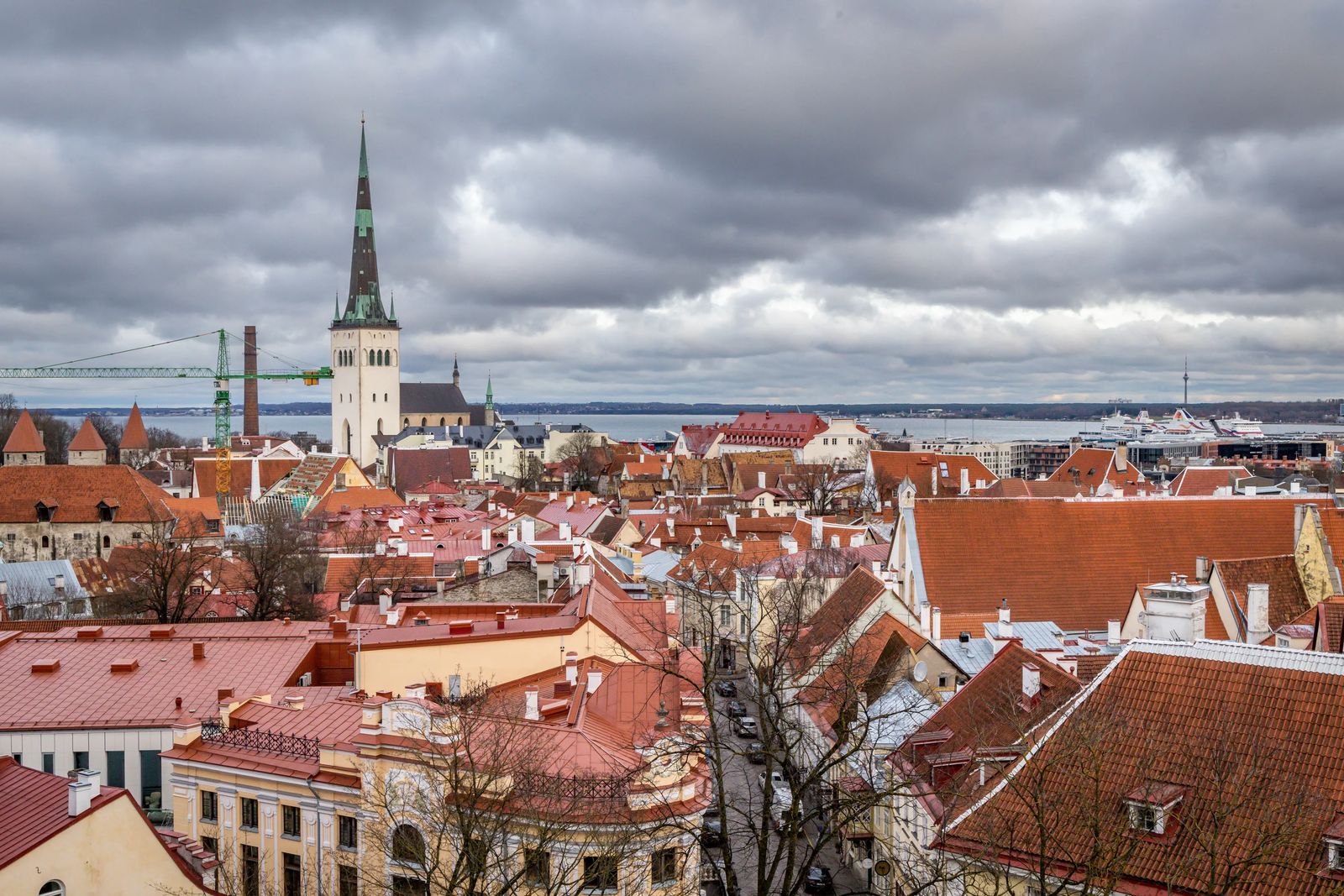
Best Things To Do In Tallinn Estonia in Winter
Estonia is a vast and beautiful land in the Baltics, and surprised me in just how wonderous and well preserved its medieval city is. In fact, did you know that Old Town in Tallinn is considered a UNESCO heritage site? If you are planning to visit, here are the best things to do in Tallinn in Winter. From the 12th-13th Cathedrals dedicated to St. Catherine, and St. Olaf who was a Viking! There is the Medieval tower called Kiek in de Kok with the underground tunnels to explore. You have the KGB Cells, TV Tower, Haunted Toompea hill and the many quirky spots in the city.
I visited Tallinn in November of 2021 and continue to update this article to bring you the most accurate information to make your trip EPIC. While many people can follow a predetermined path quite easily through the city, many don't make the effort to truly understand the history behind the places they visit to make it more meaningful and provide a better understanding of the triumphs and atrocities the citizens have endured that have helped shape the personalities of the countries people. To learn more about Estonia and how inspiring the people and its city are, keep on reading.
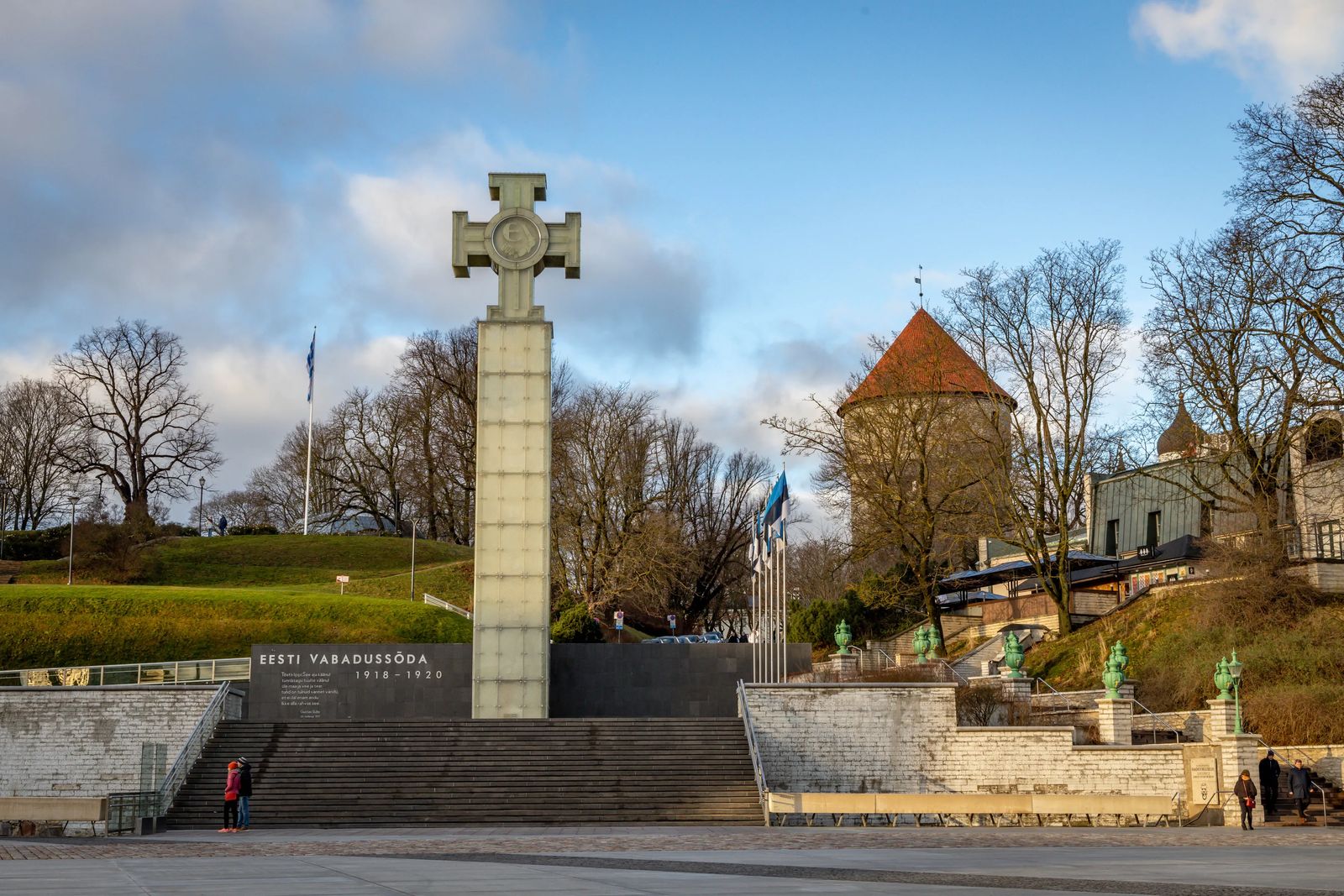
War Of Independence Victory Column
Standing 75 ft (23 m) high, the Cross of Liberty is symbolic monument erected in 2009 for all those who fell during the War of Independence. The Cross of Liberty is the highest award someone in Estonia can receive.
The War of Independence took 4,000 Estonian lives, and wounded 14,000 men, women and children. The 143 glass plates that make up the column light up a brilliant white at night, illuminating what is known as freedom square. This is often a gathering place for those who fight for justice and stand for peace in Eastern Europe.
It is also here that you will find a map of the city on the street corner near the traffic light. I suggest taking a photo of the streets of the city so you can find your way around and easily navigate to all the touristic hot spots of old town.

St. John's Church
Built in 1867 this neo-gothic church adds a bright spot of color in Freedom Square. It has three naves, with colorful stained-glass windows, and in the bell tower is located the oldest church bell with Estonian text from 1872. In 1851 there were more than 14,000 members of the Lutheran church that pooled money to help build this new parish.

Harju Gate - Smith's Gate
Harju in Estonian means Smith's Gate, was once connected to market square of the lower town. This is where all roads out of the city started and lead to the southeastern and western counties of Estonia. There was once a tower built here in the 14th century that would have overseen all those coming into and out of the city. There would have also been another tower on the inner gate with a watermill and a ditch in front of it.
There were three of these watermills that started at the gat and ended up by the sea. These watermills fed an aqueduct from Lake Olemiste.
When heavy artillery started to be used in warfare, it was difficult to defend the Harju Gate so eventually it was walled up and not used again until the the entire fortress period came ot and end and the gate was demolished in 1875.
What remains of the gate are colorful stones in the street where you can see where the outline was right near Freedom Square.

Old City Walls
This is one of the few cities in Europe that still retained its medieval walls from the 12th century. When considering demolishing the walls in the early 19th century, it boiled down to the fact that they couldn't afford to demolish the walls, so they stayed. The city has been built around them an integrated into a modern feel.
Especially at night, when the walls are lit up, the tiny shops, and you walk near the walls - it truly feels like you have been transported back in time. Even Rome felt like a modern city with a few areas of Roman ruins, this city is far different in that it truly feels like a few knights in armor on patrol wouldn't be too far out of place.

St. Nicholas Church
Dedicated to the patron Saint of fishermen and sailors, this is St Nicholas Church, and was built in the 13th century. It was partially destroyed during the Soviet bombing of Tallinn in WWII but has since been restored to its former glory.
Previously the church was used not only for worship but also for hiding refugees who sought sanctuary. There were defensive functions to the church including heavy bars at entrance doors, secret exits and also tucked away hiding places. After the church was restored, it lost many of those defensive functions, and became more baroque in its appearance with the tower rising 344ft (105m) above the city.
While it has seen many people worship here, it is now used as a concert hall as well as a museum to display beautiful religious art from the Art Museum of Estonia on its walls. The most famous piece being the Danse Macabre by Bernt Notke.

Town Hall
This is the Oldest town hall in Northern Europe, and the best preserved that is in the Gothic style. It is a centerpiece in the heart of Tallinn and exhibits just how centralized and walkable this medieval city really is. You can see the spire rising throughout the city, it helps you keep your directions straight and is an excellent central meeting place easily reached by a 2-10 minute walk from many of the hotels in the city.
It was built nearly 700 years ago, completed in the 14th century and is still used as a gathering place for locals for receptions, concerts and small plays. The spire rises 210ft (64m) above the town with a rooster on top to indicated which way the wind was blowing, and has been there since the 15th century.
In medieval times this town hall would have been used to also put on plays as it still does today. However, it was also where the town council would discuss politics, the economy, hold court, and introduce new goods to merchants. The square would have been filled with merchants, farmers, and where the town gossip could all get started. If you go during the Tallinn Christmas Market it is easy to imagine what it would have looked like during that time.
If you get a chance to attend a concert, check out the benches of aldermen from the 14th century.
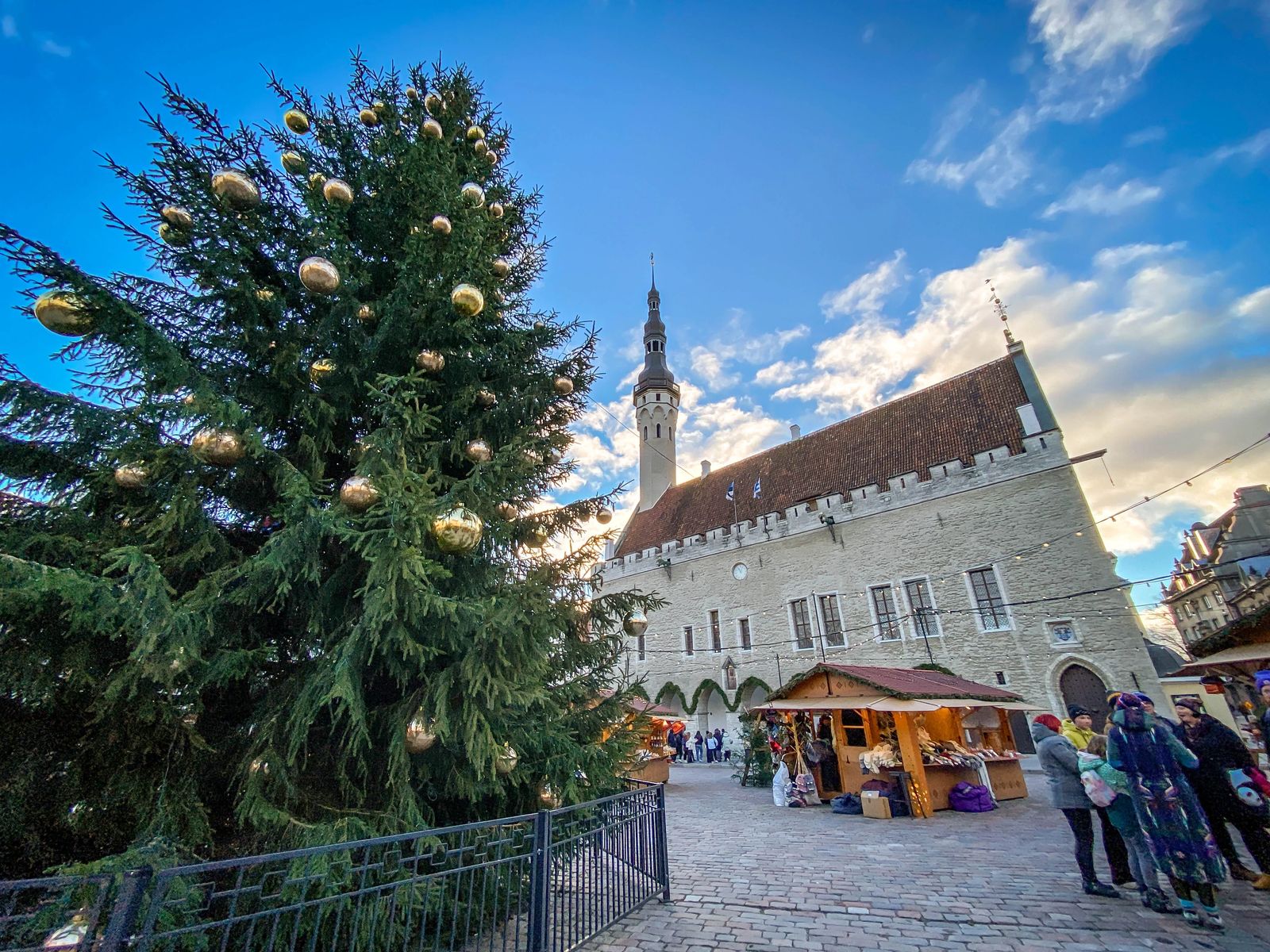
Tallinn Christmas Market
The Christmas market here is one for photographers, those who love the feeling of community during Christmas and meeting local merchants that sell their crafts. When I went to the Christmas Market it was still quite small as it was just after the Baltics had reopened (2021).
Even going in 2021 it was WELL worth it, as there was plenty of Glogg and Glogi to be had. My friends that came with me found both alcoholic and non-alcoholic in about 25 different kinds and flavors. There were wool hats and ponchos of every variety, traditional Christmas gifts, and some more modern creative ones thrown in.
You can get your fill of specialty beef jerky and dried goods as well while here. In total I think there were about twenty to twenty-five stalls in the market, with two sides to the huts, each with a different merchant (unless they had rented out the entire hut).
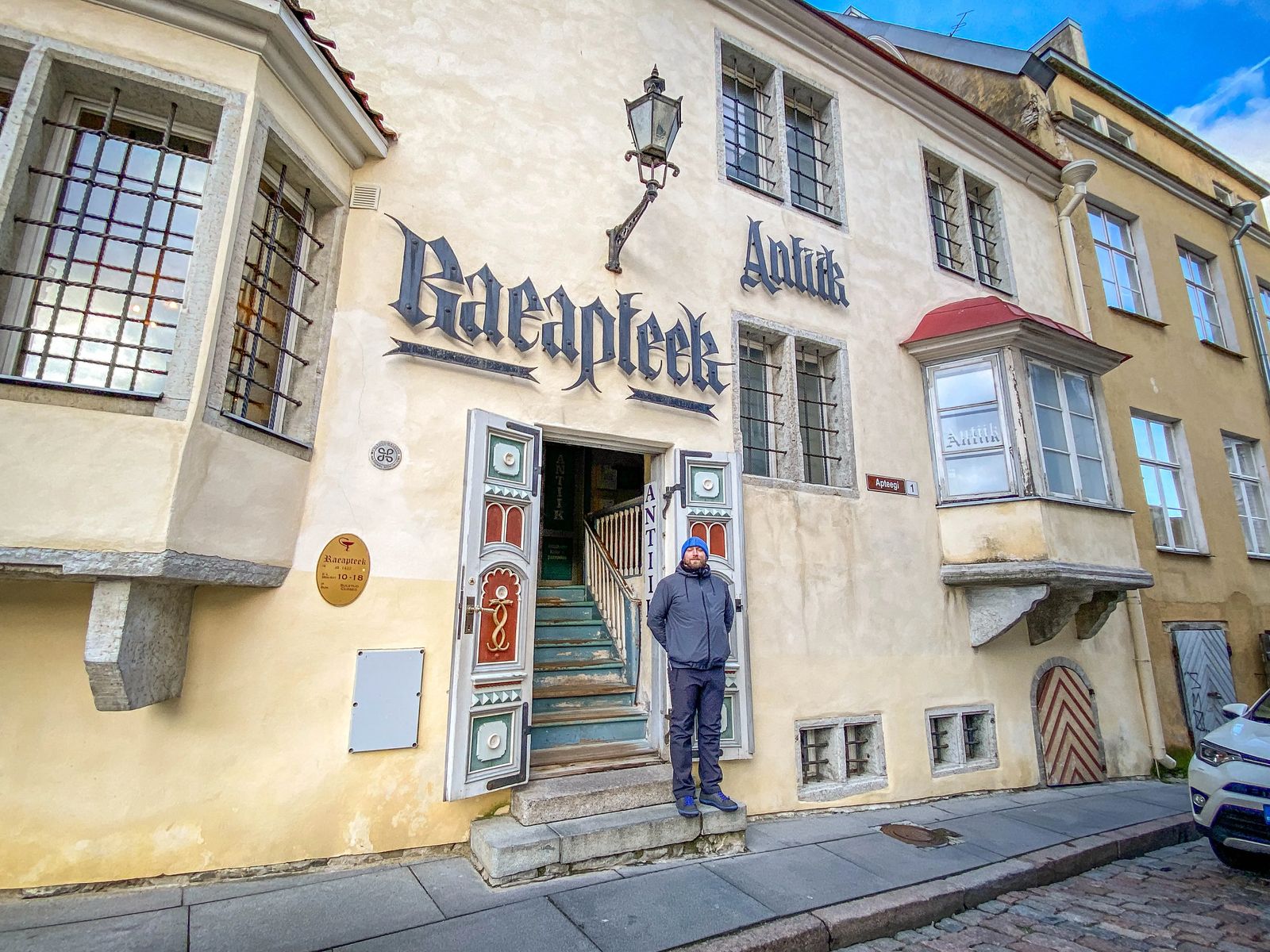
Raeapteek, Oldest Pharmacy Operating In Same Location
This is the oldest pharmacy in the world still operating at its same location it has been for hundreds of years. (Fun fact: The oldest pharmacy in general is actually in China, but it isn't operating in the same location). The oldest records indicate that it was opened some time around the year 1415.
In medieval times it was herbs, distillations and sometimes even magical concoctions that were used to treat ailments. They also dealt a bit in the black market at times by brewing the best weapon among nobles....poison.
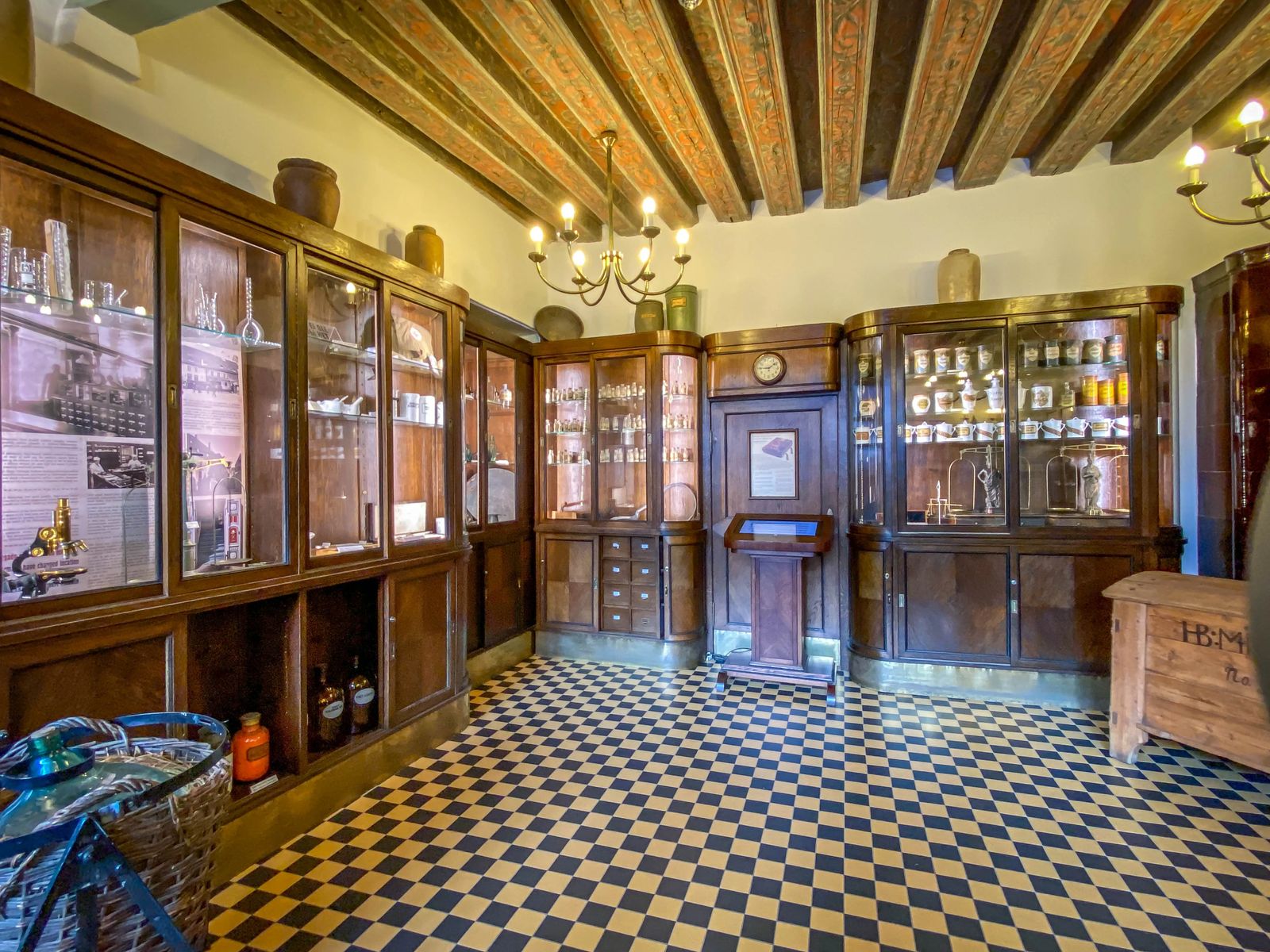
The first Chemist here was named Johann Molner, after that the pharmacy passed to the Burchart who then ran the pharmacy for 325 years from 1582 to 1911. The Burchart sons often inherited the business along with their fathers name of Johann. They were not only pharmacists, but also physicians and played a significant role in the health and wealth of this town.
Through the Black Plague in the 17th century, the Great Northern War, and even being called to attend the Russian Tsar Peter the Great on his deathbed this family survived and thrived. Sadly in the 18th century the ailing Burcharts leased out the pharmacy, and the last male heirs died. The Buchart women sold the pharmacy and their reign here came to an end.
If you go to the Estonian History Museum you can still see some of the curiosities and collections that the Buchart family kept over the years. They also have a great display in the back of the Pharmacy if you walk past the registers and patrons. See if you can spot the Unicorn horn powder and the Burchart coat of arms dating back to 1635.
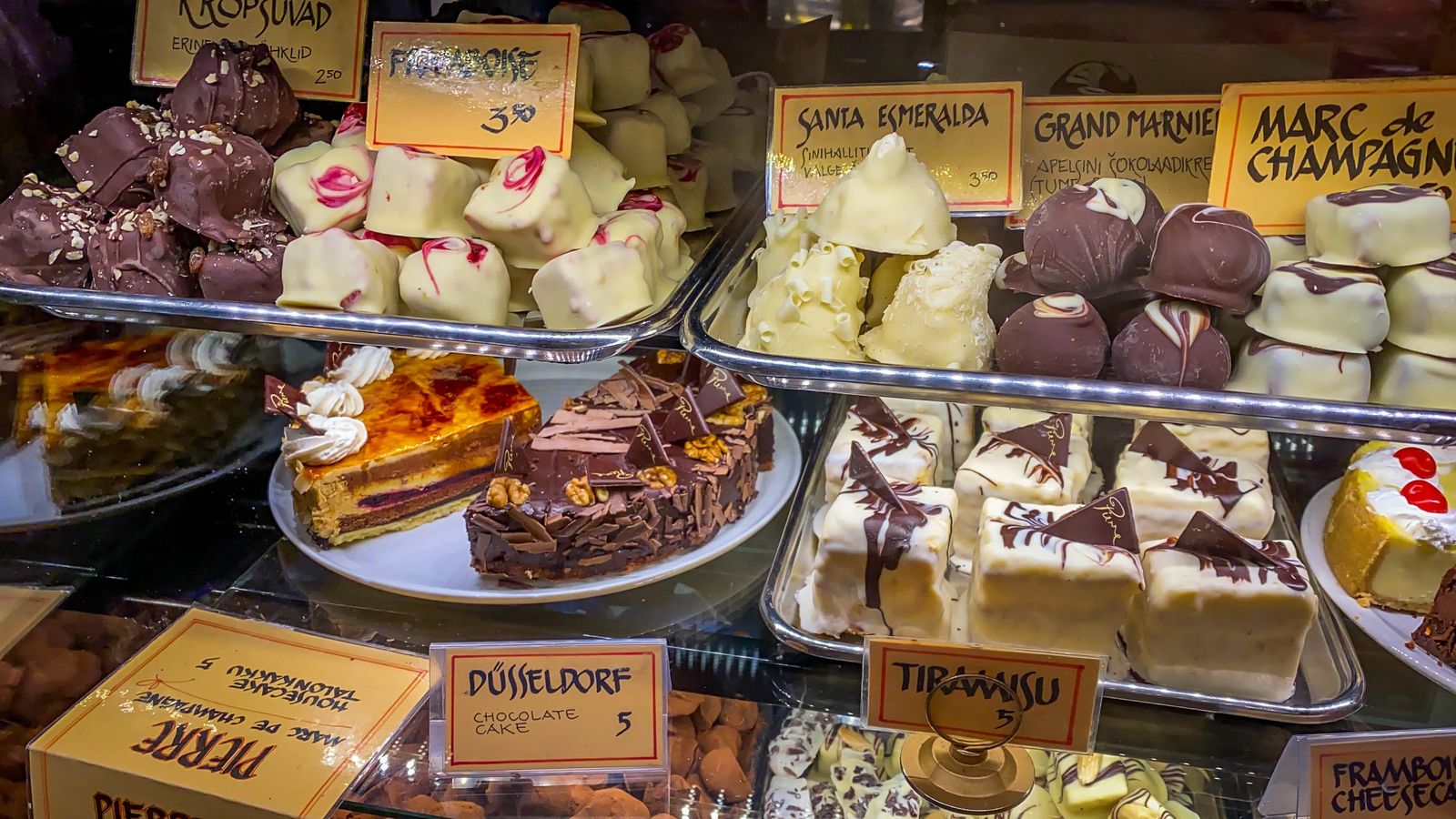
Le Grand Cafe De La Ville
I'm going to cover 'The Best Places To Eat In Tallinn' in another article, but wanted to include a delightful Marzipan shop in this article because it is so much a part of the culture in Estonia. This Marzipan and sugary delights shop called The Grande Cafe has been operating since 1937 with a bold and extensively comprehensive menu.
Walking into the shop feels a bit like walking into a palm readers lounge, but instead of the future, you get fattened with all sorts of delicious delicacies.
Marzipan is one of the oldest known sweets that was made in Estonia. It was one of the items sold in Town Hall and likely at the nearby Pharmacy as it was said to have healing properties. Germany and many other European nations claim to have invented Marzipan, however, Estonian historians will put up a mighty fine argument that they did.
Regardless, having Marzipan for the first time in Estonia was a real treat for me in more ways than one. I found Marzipan here to be creamy, just the right amount of sweetness and surprisingly filling and delicious - even for a mid-morning snack ;)
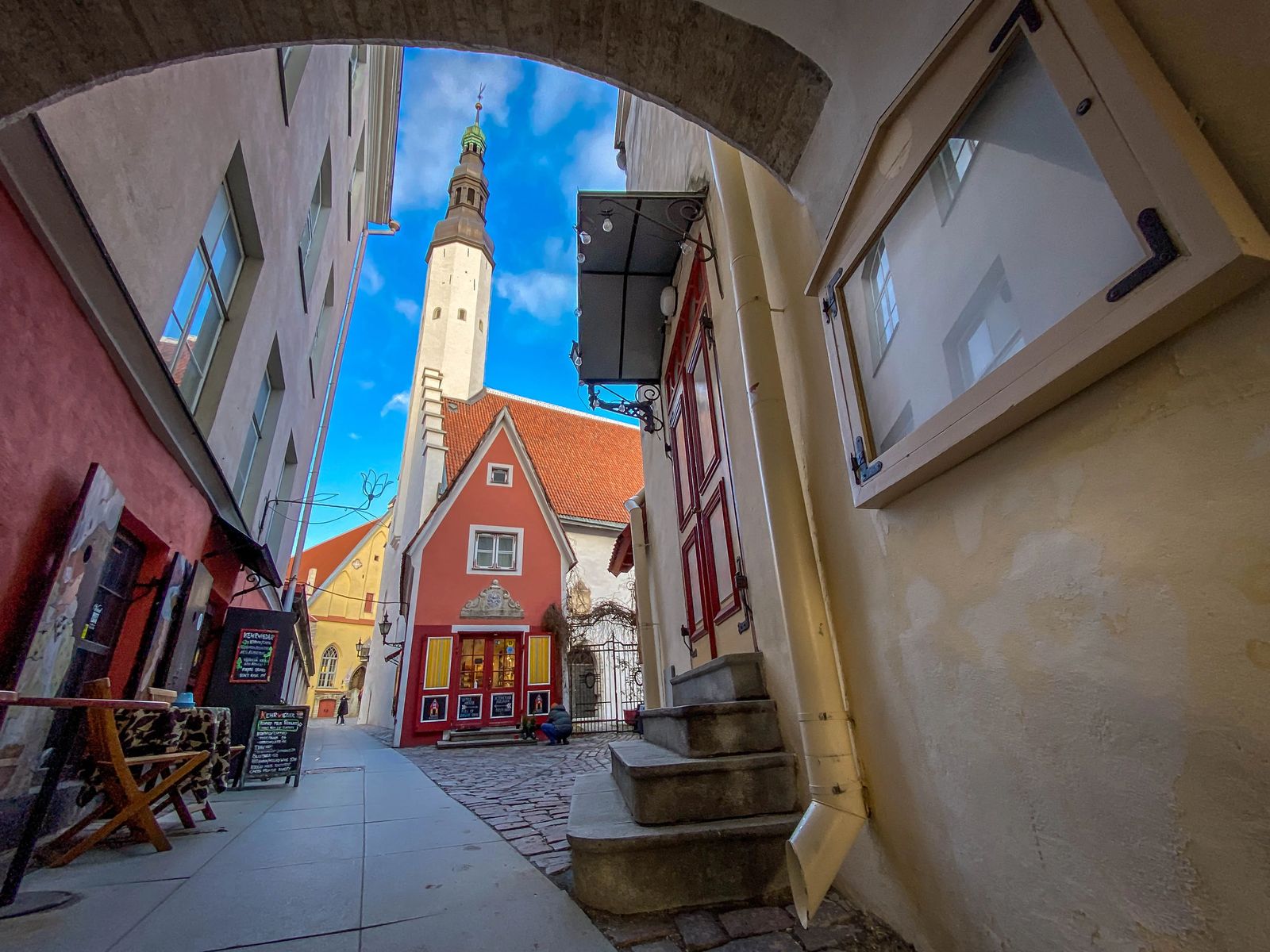
House of the Priest - Smallest Home in Tallinn
In the medieval times, the width of your home determined how many taxes you had to pay on that home. I guess it makes sense, especially in old town where the front of the house was the best form of advertising you could hope for beyond painting the side of a building. This is why this humble dwelling as the home of the priest for the church. It is the smallest home in Tallinn, and no longer serves a priest but an adorable little flower shop.

Oldest Clock In Tallinn
Measuring time since 1684 this clock sits just outside the Church of the Holy Spirit. Located on Pikk Street, this is the oldest clock in Tallinn. The paintings and ornate carvings were created by famous Tallinn master, Christian Ackerman. If you look closely at it, there is an inscription that reads "I strike time correctly for all, for the maidservant, for the master, and for the mistress of the house. No one can reproach me."
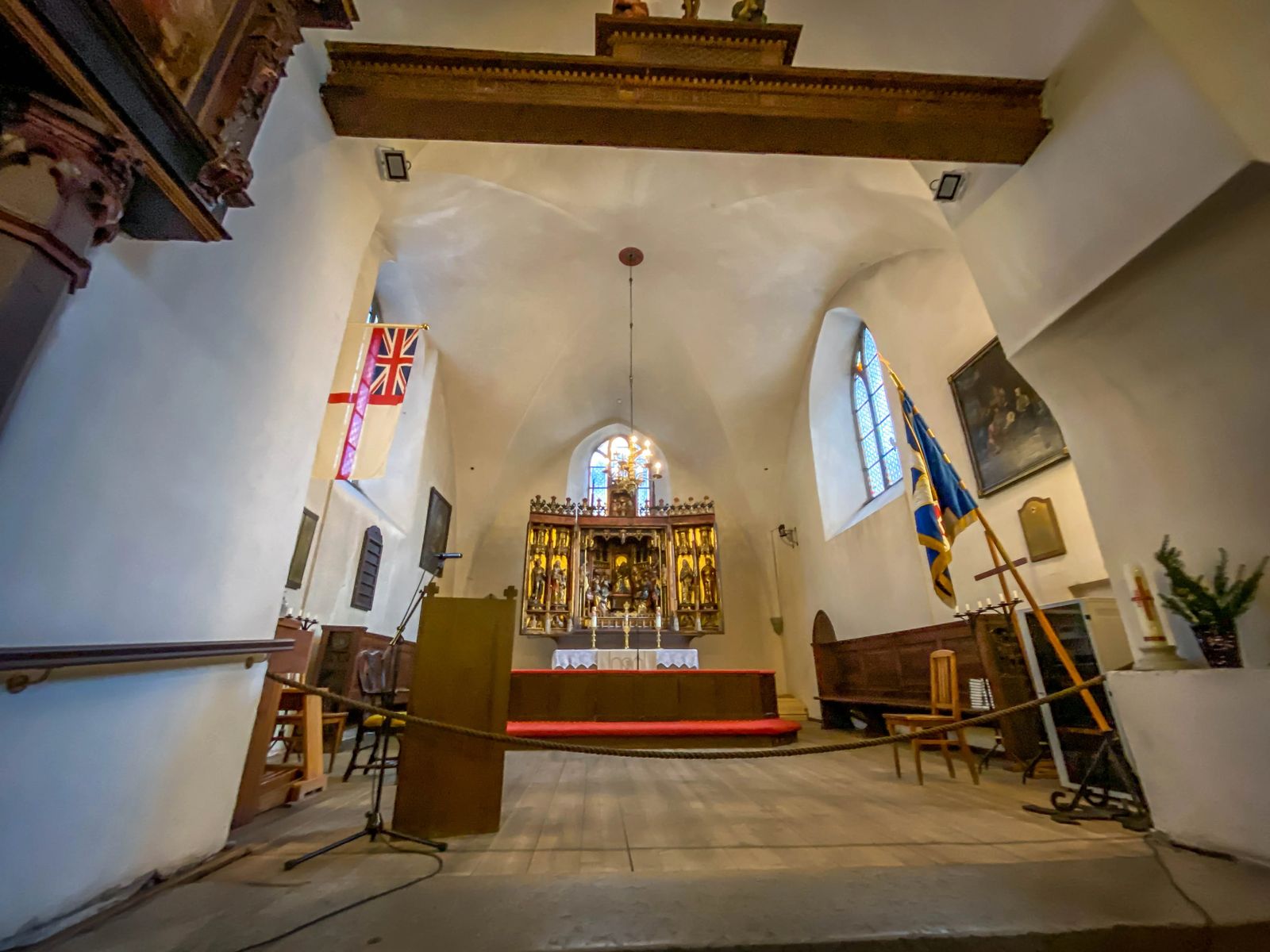
Church of the Holy Spirit
Built in the 14th century this church has undergone very few changes other than upkeep since it was originally built. Churches were the main gathering place in medieval times, where you could discuss your lives and be uplifted by the word of God.
Because Estonia was ruled for such a long time by the Hanseatic Order (German) many of the sermons in churches in Estonia were held in German. This church was the first church to hold sermons completely in Estonian, by Johann Koell's Catechism, written in 1535 and is considered to be the first book in Estonian ever written.
The wooden galleries where patrons would stand to hear the sermons are decorated with scenes from the Bible. These scenes were painted in the 17th century, and Gothic stained glass windows were added as well.

The main wooden altarpiece was made by Bernt Notke was completed in 1483. He was one of the most important masters of the German Late Gothic style. His family were wealthy mariners' from Flanders.
The altarpiece is considered one of the most outstanding chef-d'oeuvres of Estonian medieval art. If you look closely you can see the coat of arms for Estonia, not for Germany throughout the altarpiece which means it was specifically made for the Church of the Holy Spirit.
On the left wing of the altar when it is closed you see the core principles of Christianity: Father of God, the great creator of heaven and earth, the holy spirt and crown of thorns on Jesus, rays of light from Christs wounds and the symbols of sacrament.
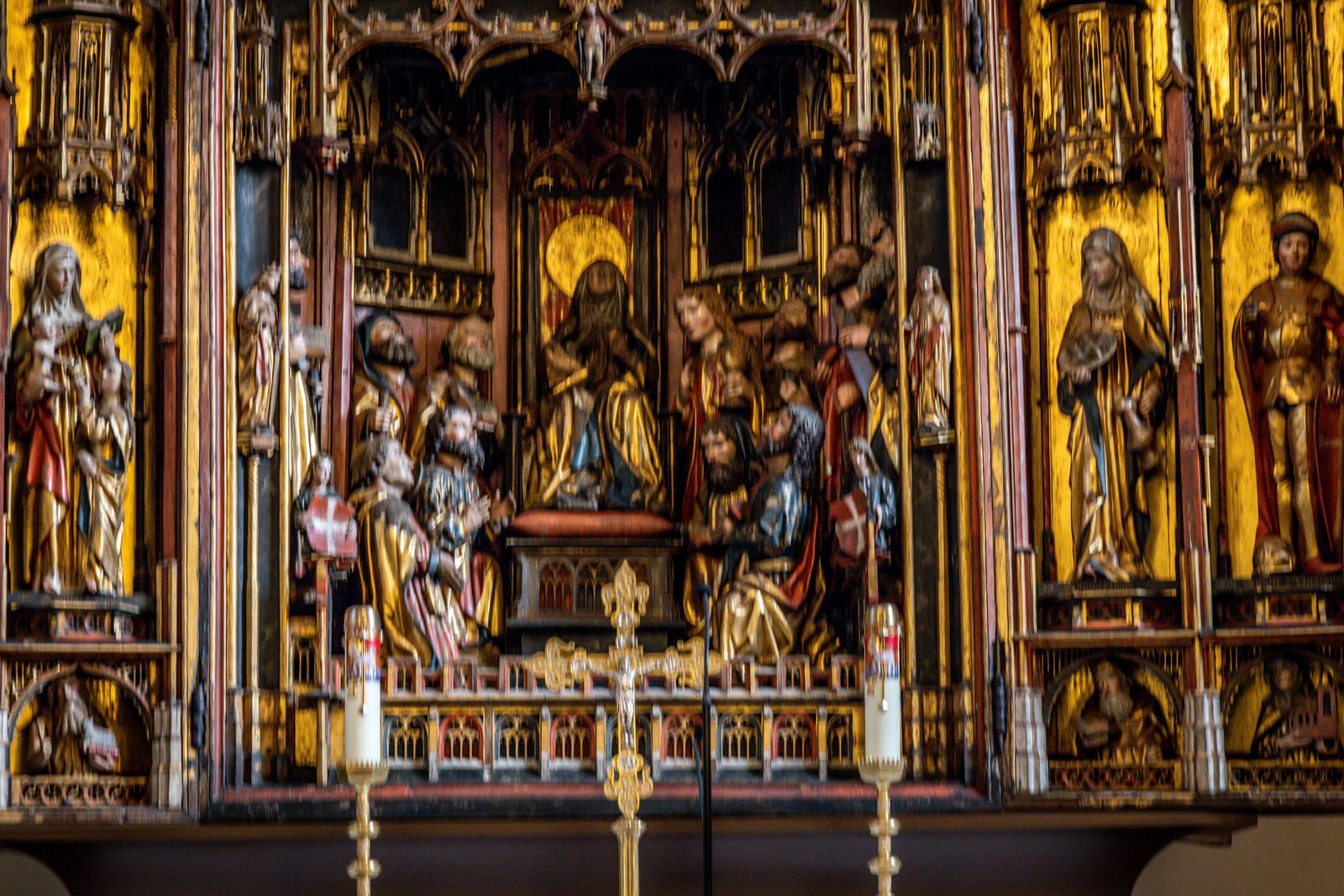
I will go into more detail on the rest of the alter and church in a separate article so make sure to check out Church Of The Holy Spirit in Tallinn Altarpiece Explained.
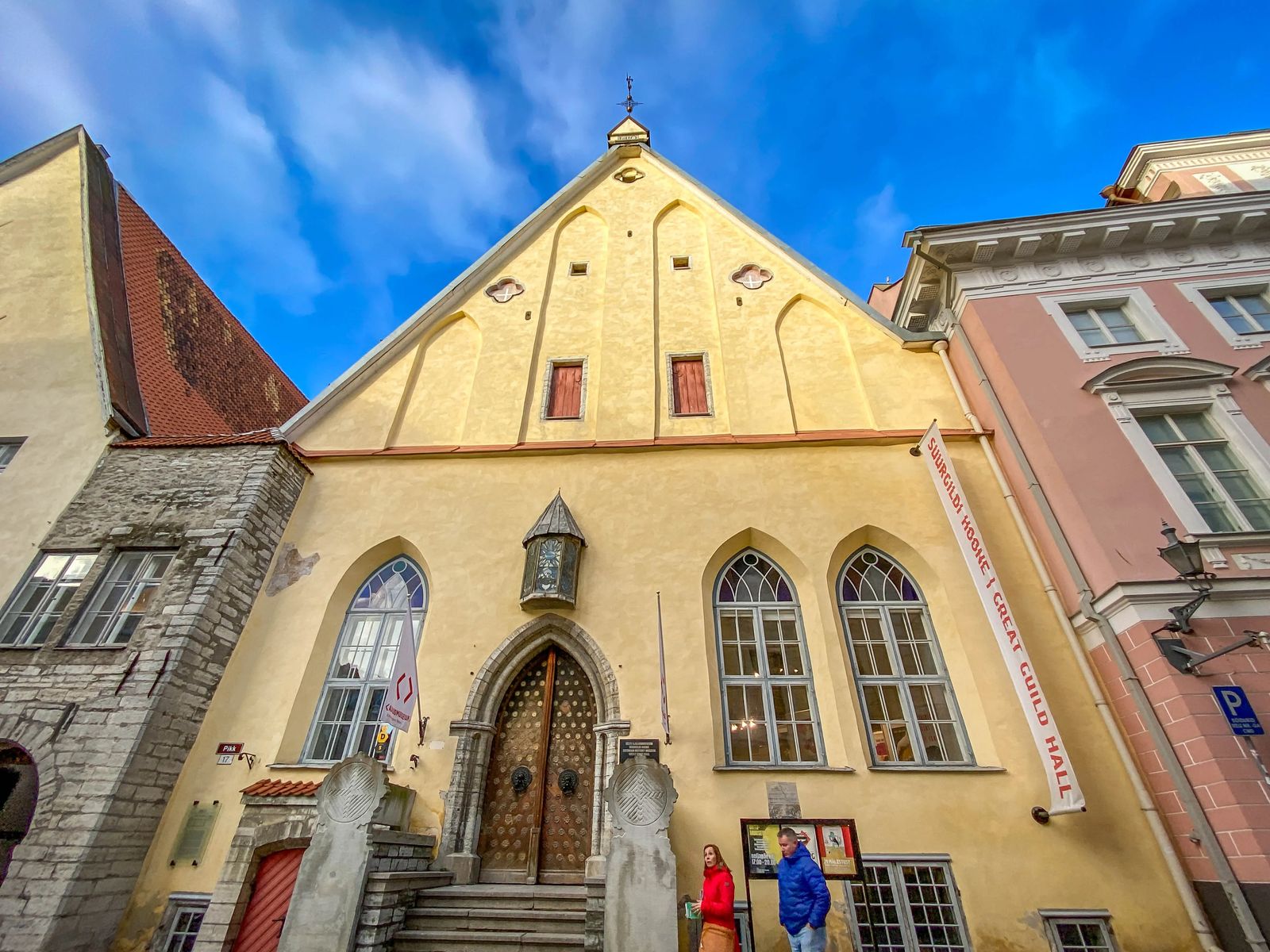
The Great Guild Hall
A guild is basically a group of people belonging to a certain class and trade craft. The Great Guild was a guild for merchants and artisans that started operating in the 14th century all the way up until the 19th century. This Gothic building now houses the Estonian History Museum, and in 2013 was named a European Heritage site.
Porches like the one here were often elevated, small, with benches, and ornate entrances. In medieval times here (and much of Eastern Europe), it was often used to flaunt your outfits, leer at ladies walking by etc... Think of them as the medieval Facebook or Tinder profiles, but in real time.
The Great Guild liked to flaunt their wealth, they installed the first street light above the front door (dating from 1640). The town had a curfew, and people weren't allowed to roam the streets. This made it easier to spot spies and potential sieges. So despite no one even walking the streets in the middle of the night to admire it they kept candles burning in the small tower above the door. While it isn't exactly electric, it still is considered to be the first street light in Estonia.
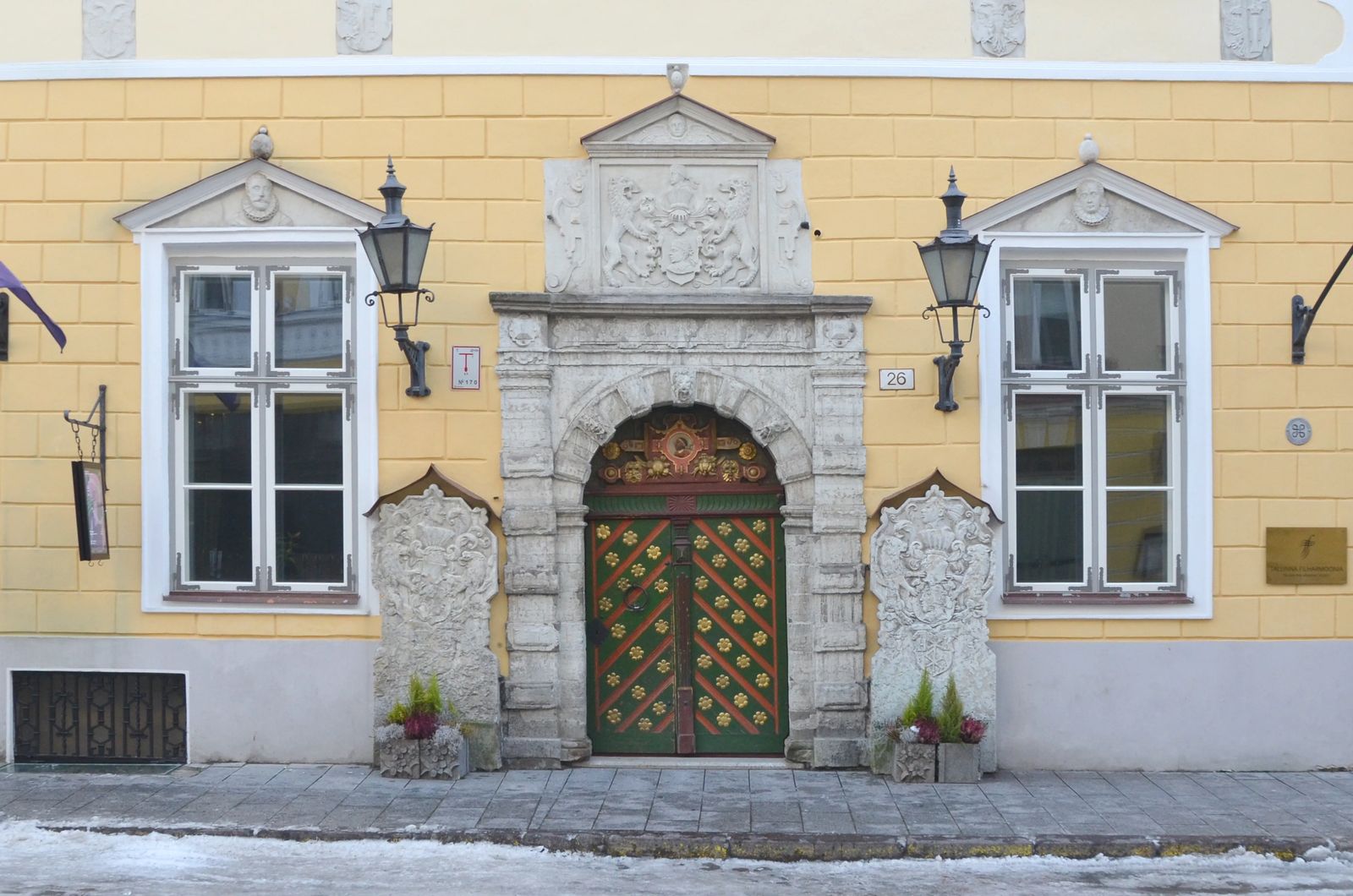
House of the Blackheads
This renaissance house once was a common room for wealthy young single merchants and foreigners. The patron saint was a Moorish Man called St. Mauritius, who is depicted with dark skin, and is included in their coat of arms. The Brotherhood came about around 1399, and was a place where they could come to discuss politics, business, a place where they could celebrate marriages and social issues as a Guild.

Helleman's Tower
The tower was built at the beginning of the 15th century and was built as added protection to the Viru gate. It was used as an ammunition storeroom and the upper floor was connected by a hatch in the ceiling. There were small openings in the lower floor for the artillery to poke through and blast the enemies away. The upper floor also had a fireplace, and a toilet in a small separate tower attachment that drained directly into the river.
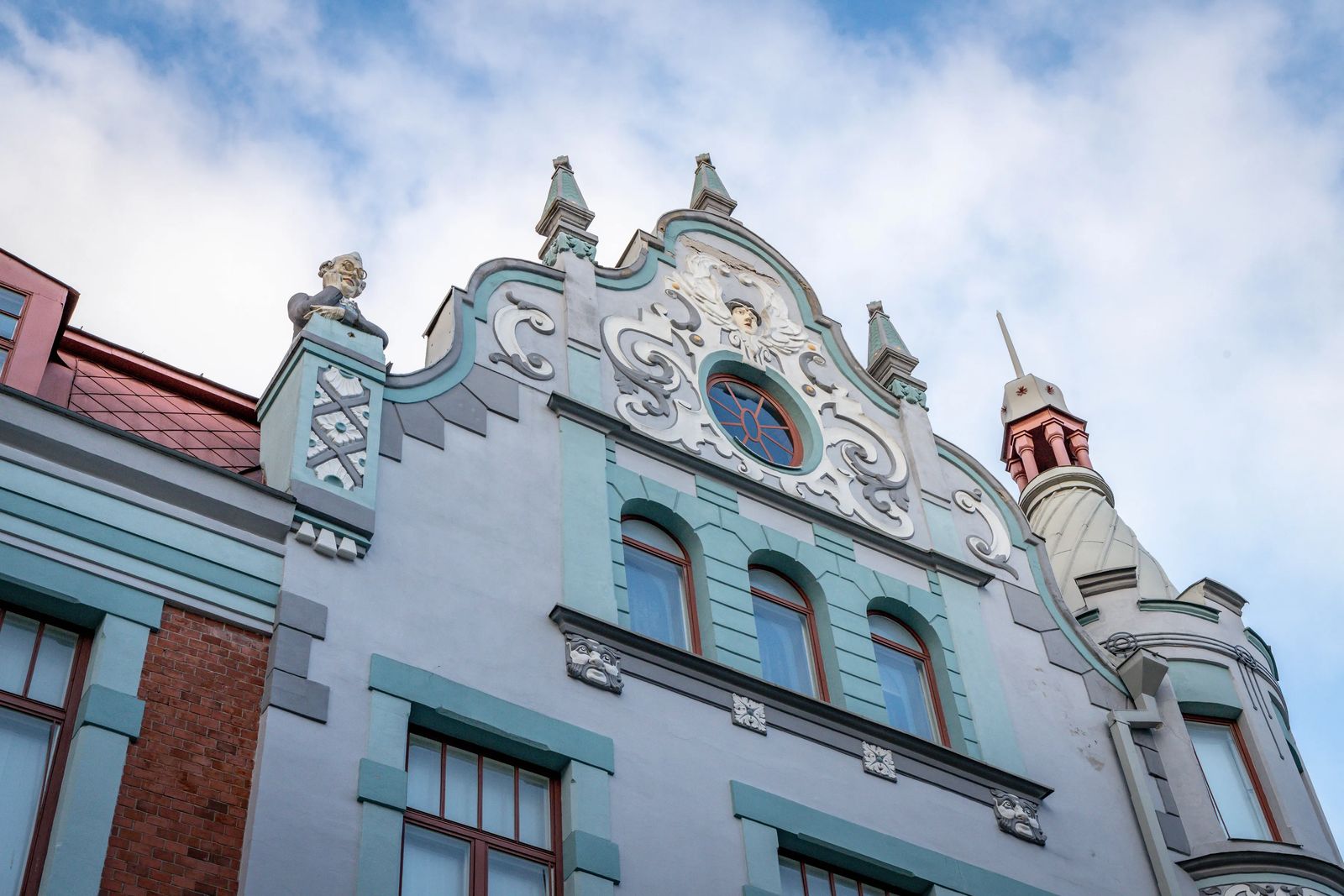
The Blue House on Pikk 23/25
This art nouveau building was constructed by Reinhold Reichmann, a famous Art Nouveau architect that was hired to enliven the streets of Tallinn with his creations. Among the details of this building is a comical sculpture of an old man gazing across the street with his spectacles.
Local legend has it that the sculpture was created (by August Volz) after a neighbor saw a man and a woman in love, doing the....well, making love. Soooo even though the neighbors complained about the scandal, they continued to make love on this top floor with the shades open. After a time the sculpture was put up at the top to show acceptance that this is just the love house and people were welcome to watch. While it isn't exactly true, that is the stories that locals tell about it anyway.
Regardless of who did what, where and who saw....this building is a superb example of German neo-Renaissance and neo-Mannerism architecture.
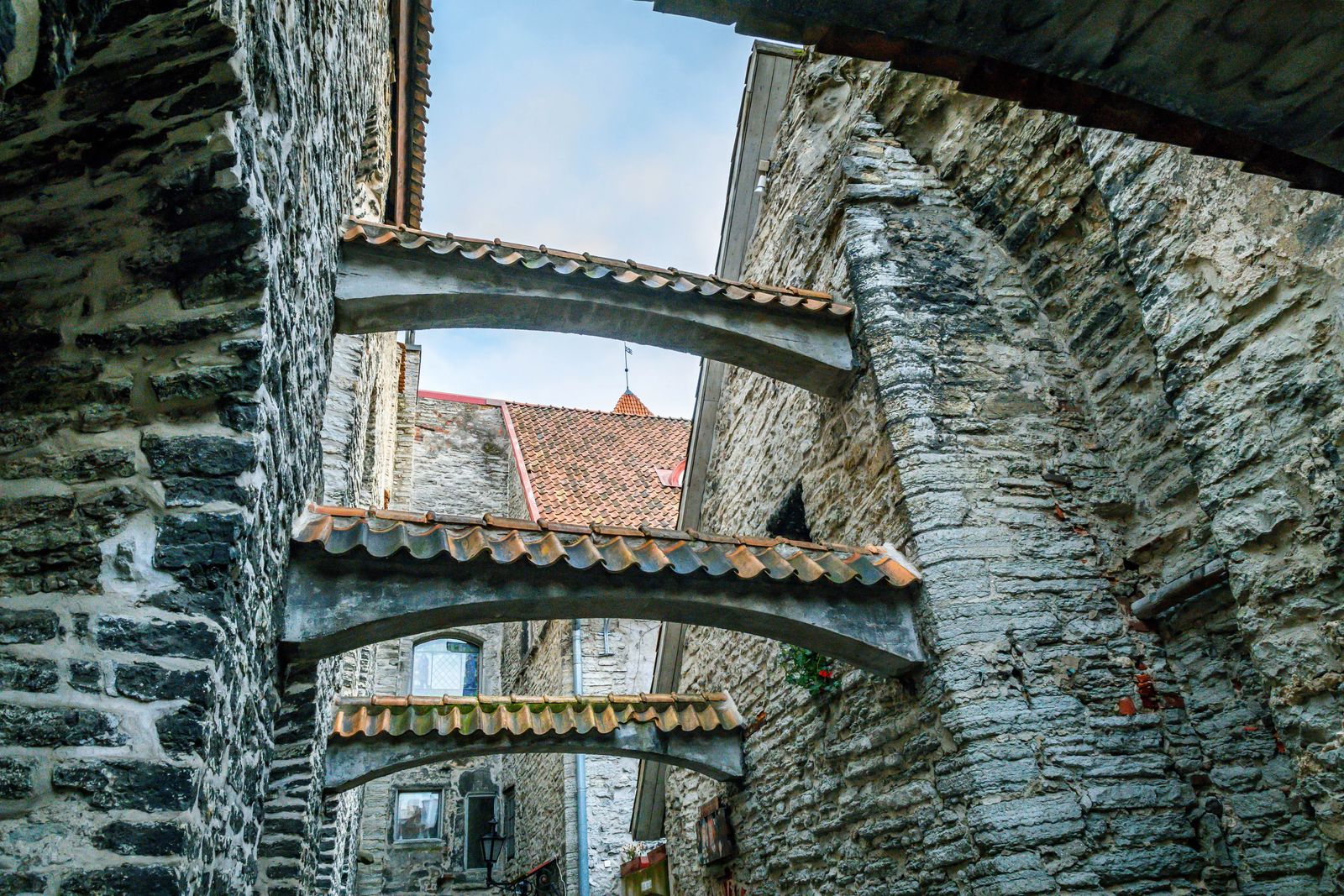
St. Catherine's Passage
This gorgeous little passage feels like you are walking behind the scenes in some medieval movie. It is probably the most instagram worthy spot in the city. It was formerly known as Monk's alleyway and connected Vene street to the Dominican monastery and St Catherine's Church.
It is more than 700 years old and surrounded by one side that feels like a city wall, and the other side that is 15th-17th century homes. The homes once belonged to members of the St Catherines guild.
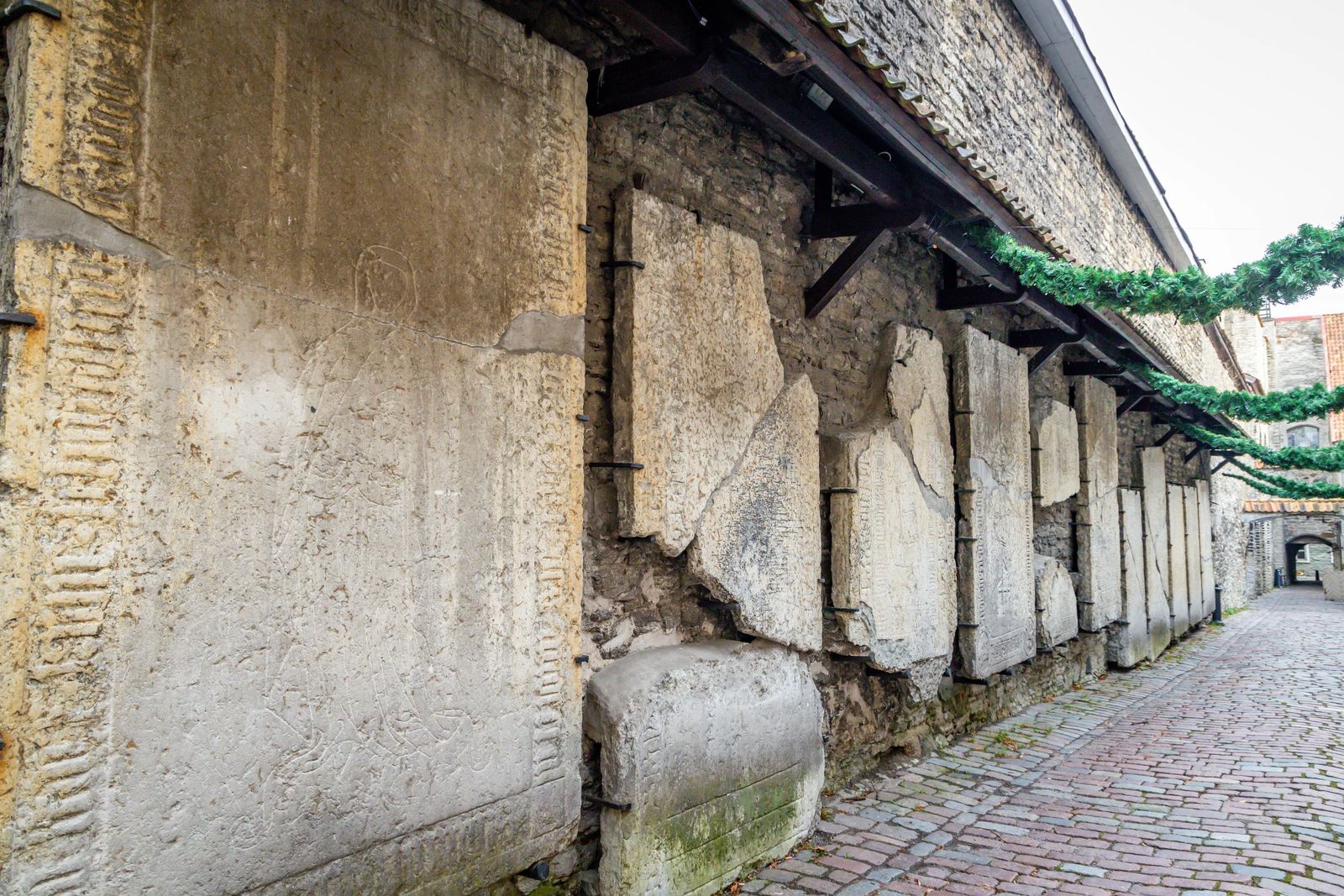
St Catherines Tombstones
The tombstones along the wall of St Catherine's Passage were from the Church of St Catherine of Alexandria. The tombstones belonged to the Magistrate of Tallinn, who happened to be a part of the Brotherhood of the Blackheads.
The better preserved tombstones were used to pave the floor of the barn installed into the ruins of the church. Others were used as a sort of display along the road Via Appia, a famous road from Rome to Cupua.
You can still find the BEST preserved tombstones that belonged to the Wacke family from the 14th century, but those are on the wall of Kohtu 6 on Toompea Hill.
It is odd to me that if you imagine yourself spending so much of your money on a tombstone to display your death and life, and hope that people remember you....just goes to show, no one cares when ya dead and your tombstone is good stone that can be used as pavers for a barn.
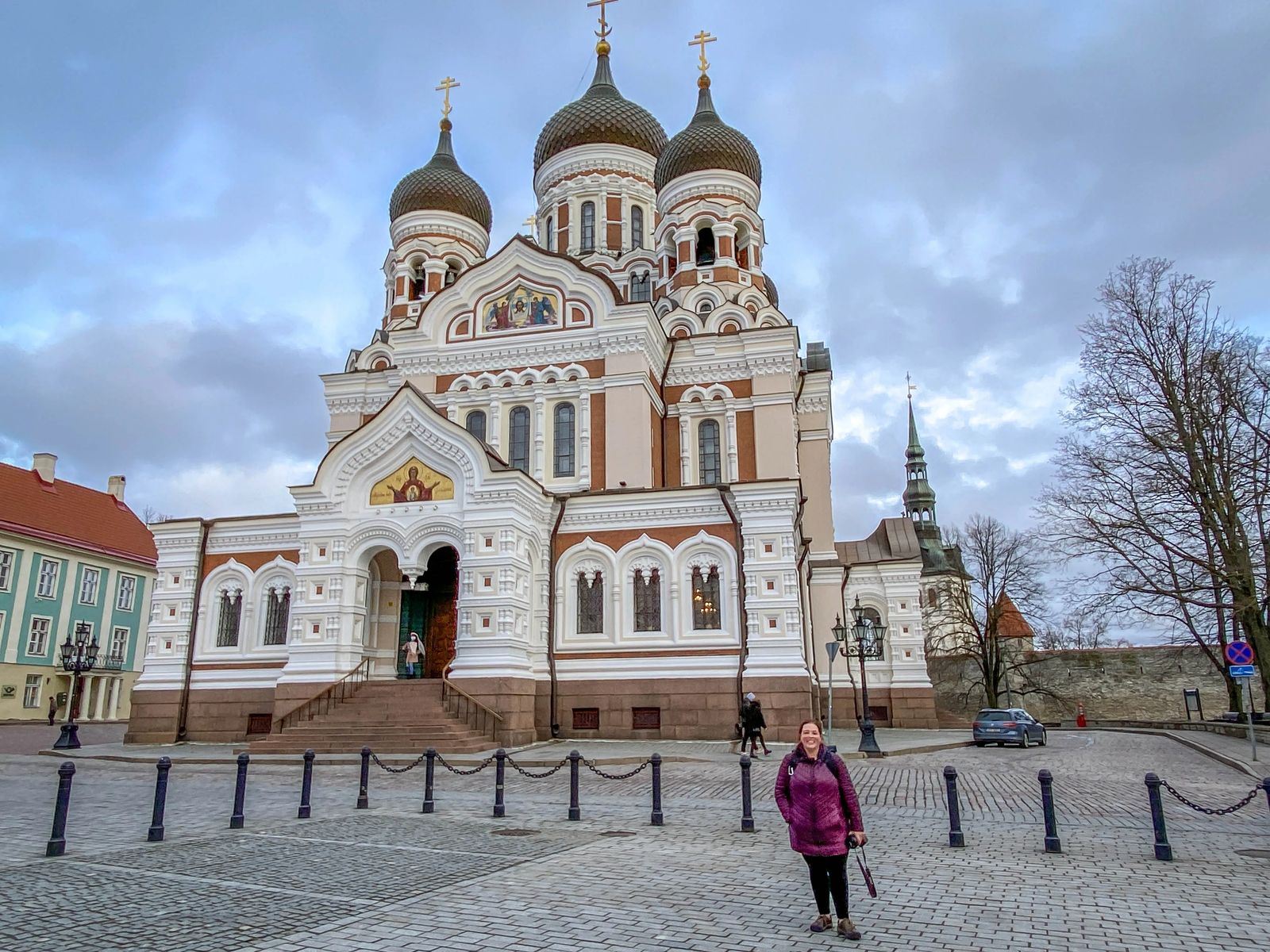
Alexander Nevsky Cathedral
Built in the 1900s when Estonia was still part of the Czar empire this Russian orthodox church is worth a visit just for the Bells. This houses the most powerful collection of church bells with 11 bells, including Tallinn's largest bell and can be heard just before services on sunday start.
Alexander Nevsky was a saint who won the battle of Ice on Lake Peipus in 1242. The Bells housed In the tall towers with onion tops were made in St Petersburg and are made out of Bronze (copper and zinc combination). This is due to the strong nature of Bronze being able to withstand the constant strikes repeatedly and not cracking.
The cathedral was very nearly destroyed after Estonia escaped the occupation of Russia. However due to the massive amount of funds it took to both construct it and would be required to destroy it - it was saved and later restored.
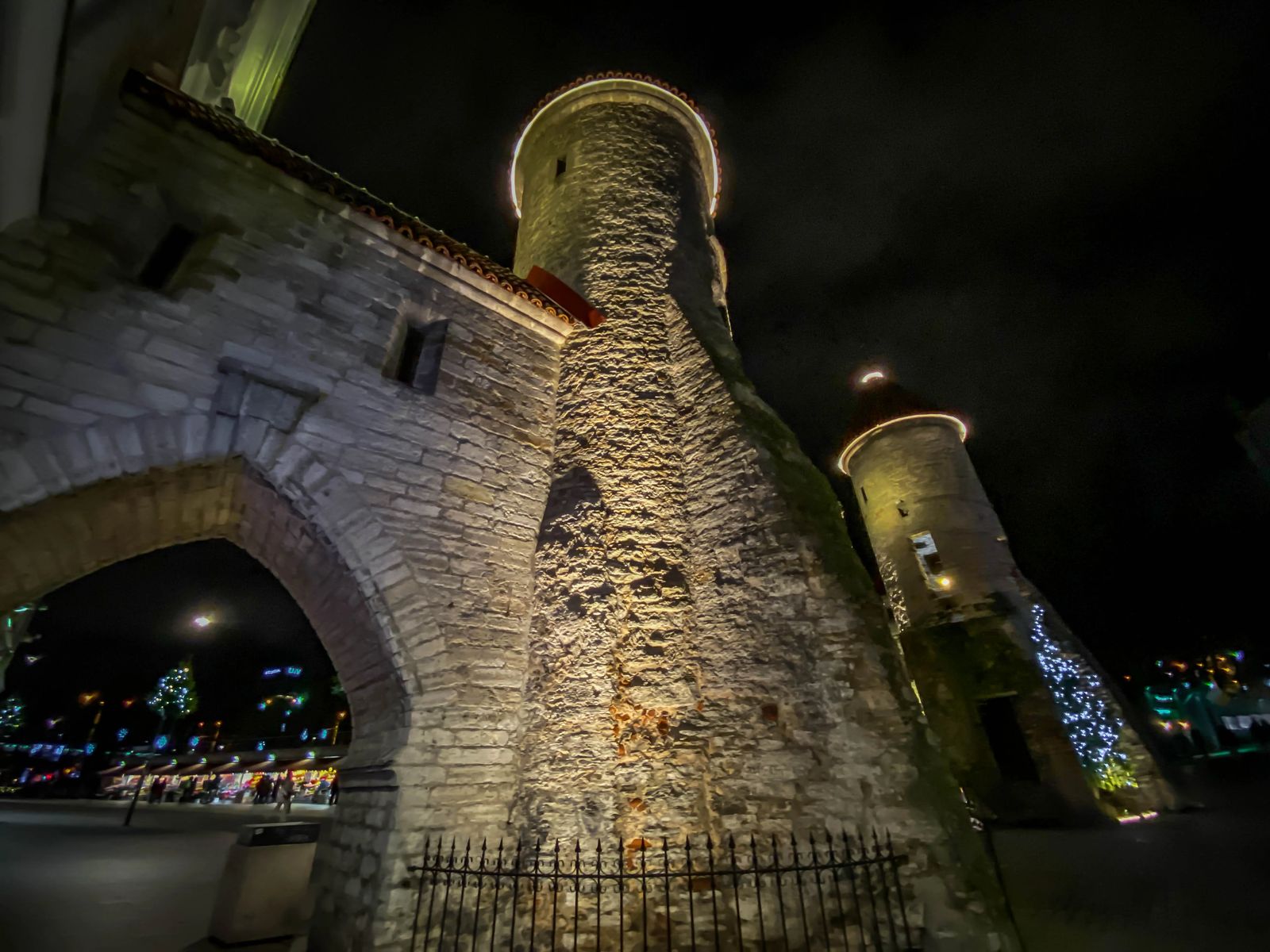
Viru Gate
Built in the 14th century the Viru gate was the main thoroughfare for horse drawn wagons that connected the Old Market with Kadriorg Palace. Because of the width of the wooden gate, it made it one of the weaker points in the medieval defense system and thus Hellman tower was built to help defend it. This street is still one of the busiest pedestrian streets in Tallinn. You can find everything from flower shops, to McDonalds, to an Irish pub housed under an old tower. Viru gate and the streets surrounding it, truly are the life of the party for tourists when visiting.

St Olaf's Church
First written about in 1267 this church is dedicated to a Viking Warrior, St Olaf. He was responsible for bringing Christianity to Norway, and remains a place of worship for Baptist congregations today. While it started out Roman Catholic, like all medieval churches that passed through the Reformation things have changed.
The church was reconstructed extensively in 1944-1991. The tower can be seen throughout Tallin at many overlooks, and also makes a good lightening rod. This 406 ft (123.8m) tall tower has been hit by lightning 10 times, causing the church to burn down on three different occasions. If I was worshipping here personally, I might take that as a sign it was time to move.
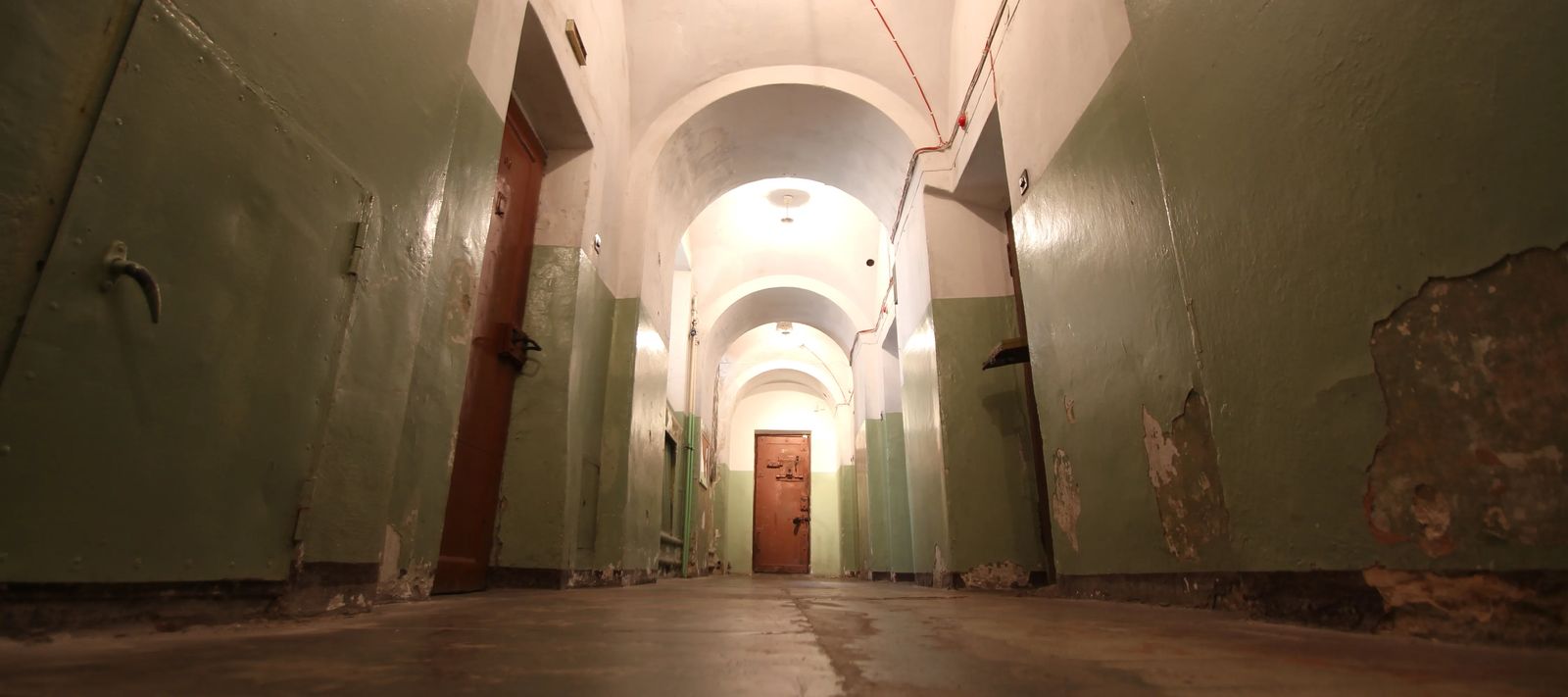
Vabamu - KGB Prison Cells
The KGB prison cells in Tallinn has been a symbol of the brutal oppression over Estonia by Russia. Those who spoke up against the ESSR (Estonian Soviet Socialist Republic) were brutally interrogated, and either shot or sent to labor camps in Siberia.
Inside you will find personal narratives about the crimes committed here, war crimes and inhumane injustices that are still felt by Estonians today. If you are sensitive to these kinds of subjects I want to warn you that there is definitely a dark feeling surrounding this place.

Tallinn TV Tower
Estonia boasts that their TV tower is the highest viewing platform of Northern Europe. It stands 1,030 ft (314m) and overlooks the sea. They have VR tickets where you can pretend you are flying around the tower, and plenty of information about how it was built. They also include history about how the Soviet Union tried prevent people from getting information from the outside world. They didn't have cell phones, internet or any of it back then, other than TV, Radio and landlines. Keeping that source of information controlled, also controls the narrative about how the Soviet Union was viewed, and kept rebellions at bay.
Eat at the cafe or restaurant there, or strap yourself in and lean out over the edge. You might want to lean out over the edge, and then eat though, just in case you get queasy from heights, lol.
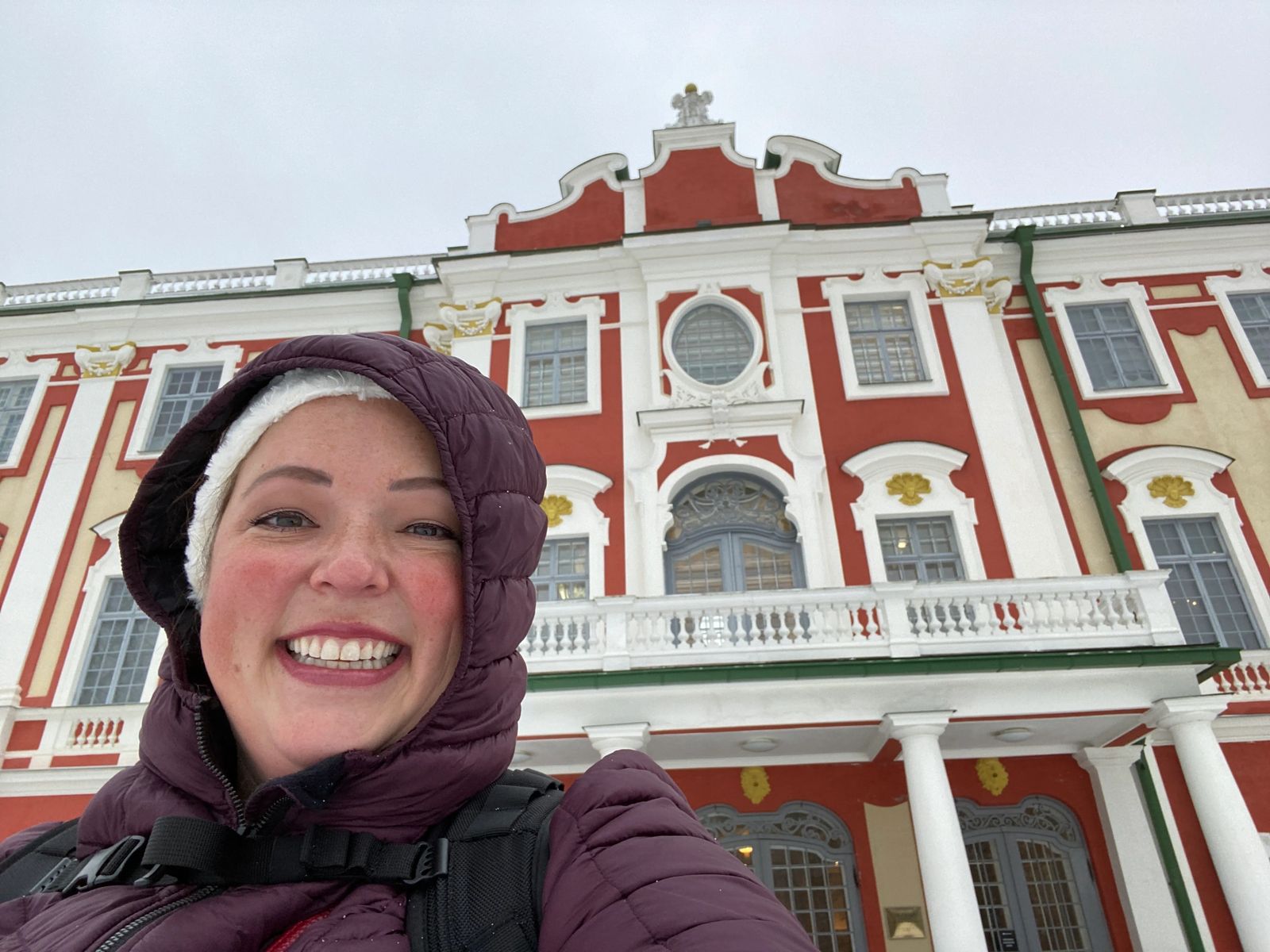
Kadriorg Art Museum
This gorgeous former Palace was built by Peter the Great in 1718. It has a very ornately decorated main hall when you enter, and is warm and quiet in the winter after a long walk over from Old Town (BRRRR - Take a bolt to save you from frostbite).
What people don't realize about Peter (yes we are on first name basis here) is that he wanted to have Russia be viewed as European. He started to change the views on Russia by first changing the architecture to reflect that of Europe and not as much Russia. He named the palace with a German name in honor of his wife Catherine I, and then immediately got to work bringing in the BEST craftsman to put this gorgeous place together.
This was the summer palace for many of the rulers in Russia, but in the 1920's it was turned into an art museum. It changed hangs a few times, but since 2000 it has remained an art museum with has the largest collection of old western European and Russian art in Estonia.
There is a shop, cafe, along with concerts, permanent exhibits, and guided tours of both the art and the rooms to know who sat where and who painted what and why it is all so important to the culture of Estonia.
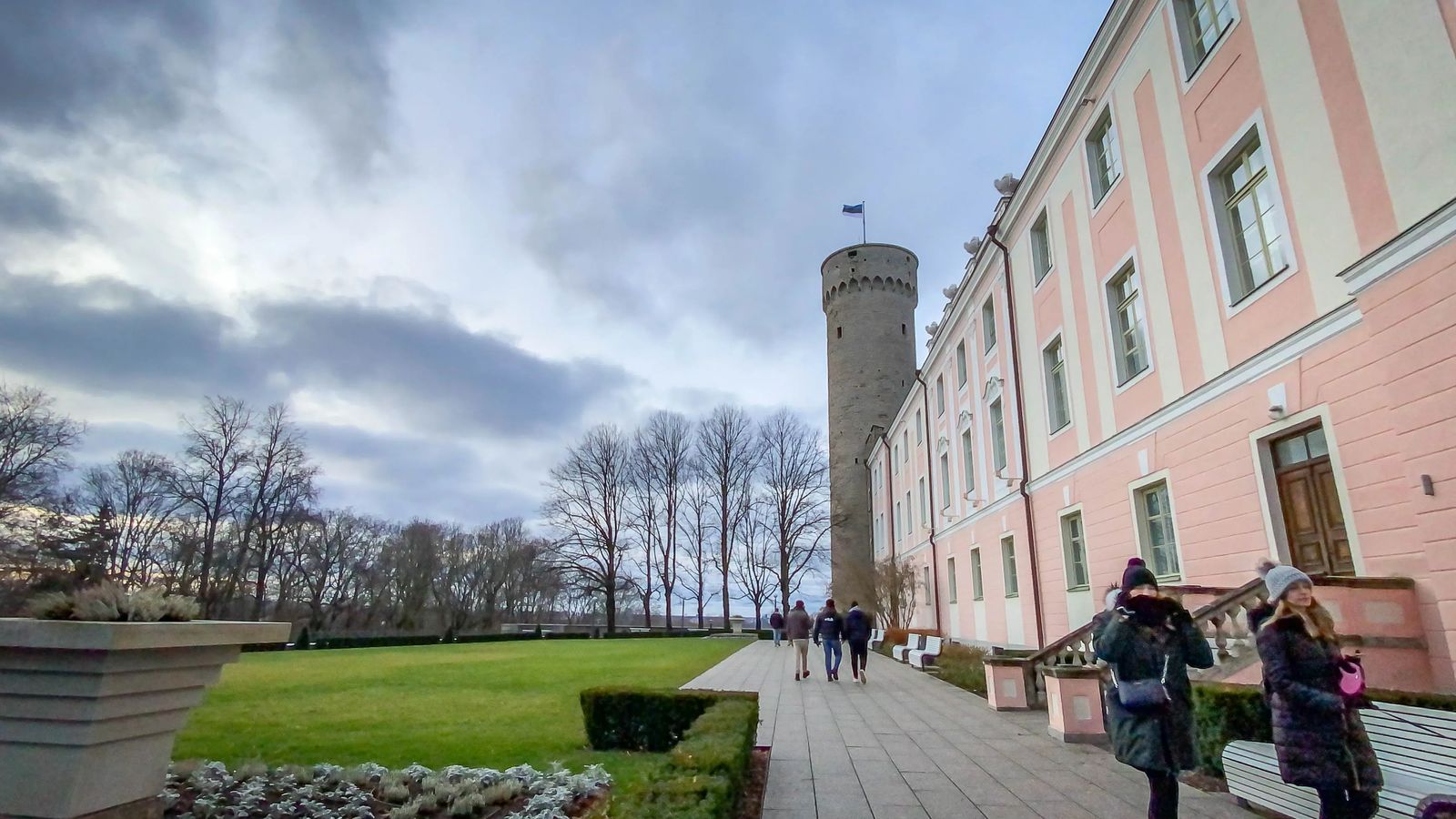
Toompea Castle
There are two parts to this castle, the older part which legend has it was built by Linda who built it by hand, by himself boulder by boulder. Then there is the second part that is newer, this houses a lot of the Estonian Parliament now with lovely gardens outside and a cute pink exterior (worthy of an Instagram photo).
The Castles first known written residents were the Danish crusaders (remember this when we talk about the Danish Gardens), then there was the Teutonic order (looked like a monastery at that time) and remained in their hands till the middle ages. The the Livonian War happened in the 16th century and Sweden, Poland and Russia all fought like step children until Sweden claimed the castle. The Swedish are responsible for the current look of the castle today. They brought it from a cold looking castle to something more modern.
Sweden lost the country to Russia who turned it into a place to handle the politics, and then when independence was won in 1918 it officially became the parliaments permanent home for Estonia.
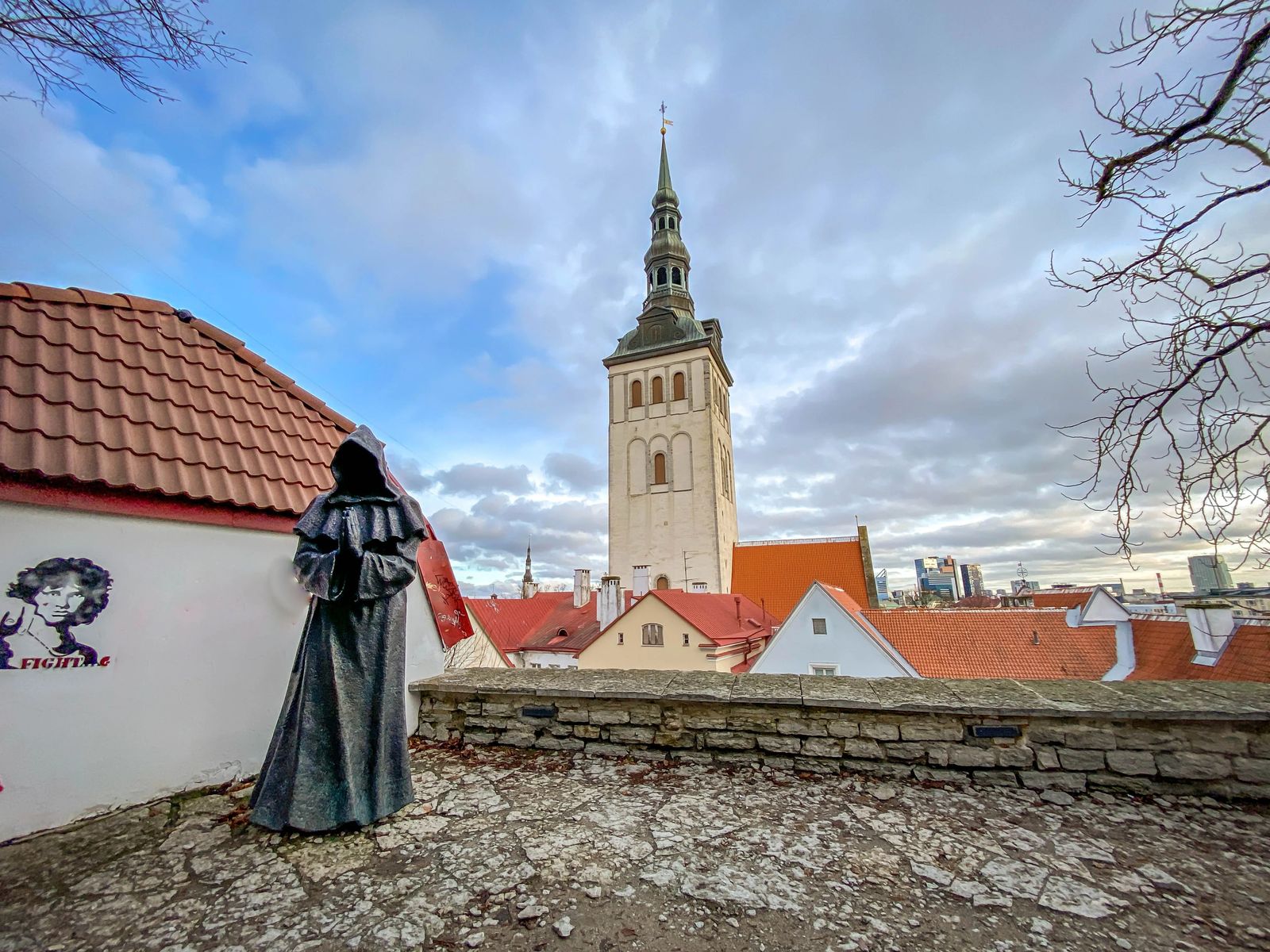
Danish King's Garden
This is the QUIRKIEST little garden I ever did see! They have these creepy monks, next to 1980's graffiti, with a only a few trees, a bit of grass and lots of stone. So why is it called the Danish King's Garden?
Legend has it that this is the spot where a flag descended from the sky during the Danish invasion of Estonia. The flag falling in the exact spot that it is painted on the ground, is said to have turned the battle in the favor of King Valdemar II allowing the Danish reign in Estonia to last over a century. To see the flag painted on the ground, you have to CAREFULLY peer over the edge and see it on the ground below.
This is also an epic spot to take Instagram photos and epic views of the city.
The Monks....ahem, the very creepy monks here are said to represent the three monks that were killed here. Two of them are said to still haunt a nearby building, thus the ones up on walkways above the garden, and are lit up at night - further adding to their creepiness. So why are there four statues of monks and not three? No one knows.....maybe one of them is that creepy Nun from those horror movies.
Bottom line, Estonia is quirky with its art like that - and I also need to go back to to do a proper ghost tour of Tallinn.
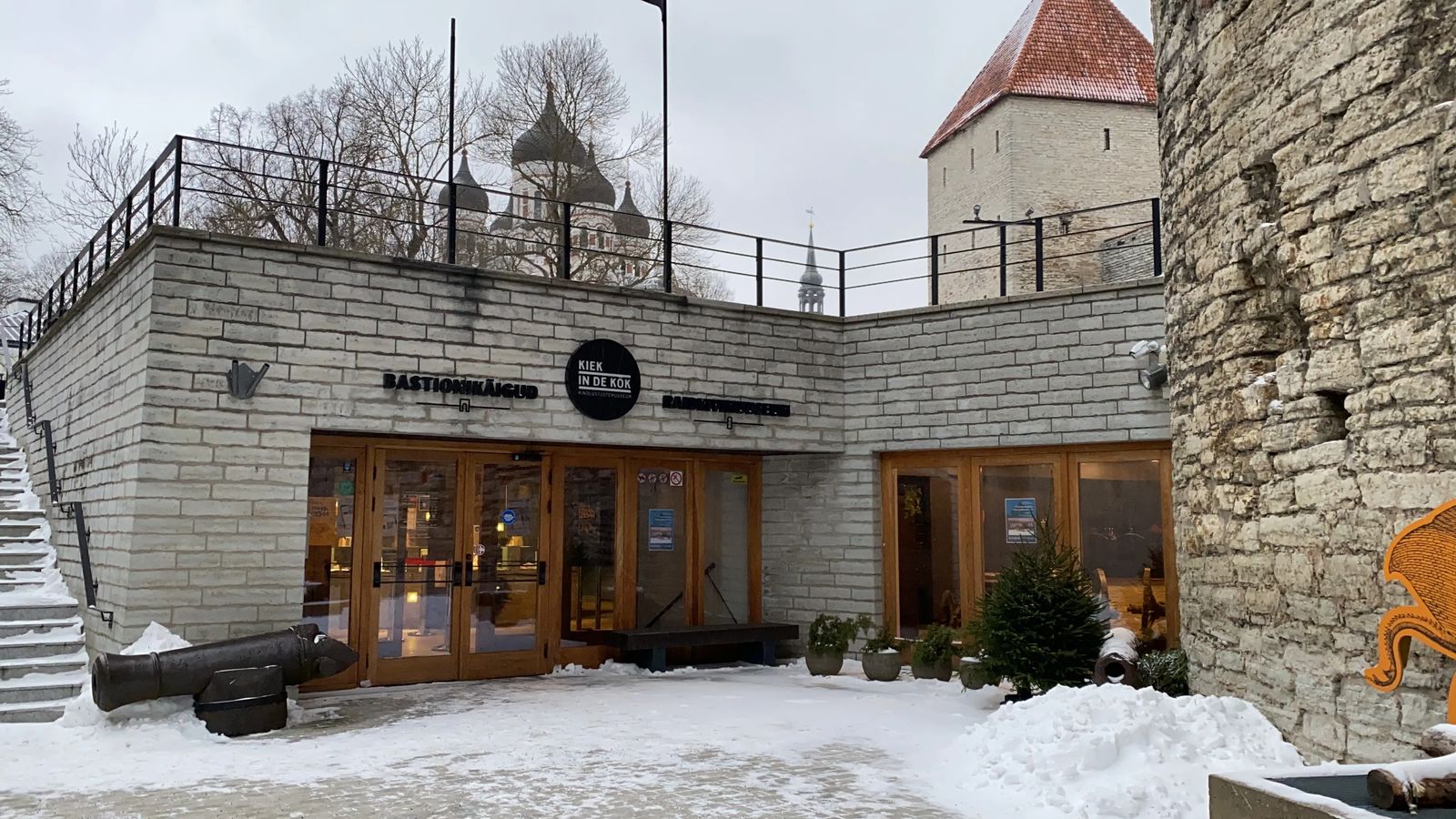
Kiek In De Kook Museum
Not only is the name of this museum fun to say, it is also where I had a very close call with the most embarrassing moment of my life. That part will be continued in the next section though. This section is about the tall tower called Kiek in de Kook that houses a lot of military history. Stunning views of the city through the tower windows if you make it to the top.
Starting from the bottom floor and working your way to the top, you get an overview of how Tallinn actually would have started. The bottom floor typically has a temporary exhibit laid out, when I went it was about the legends and Pagan practices of Estonia. You then head up to the first floor (passing a medieval toilet along the way - please don't try to use it folks) and end up seeing some of the defensive tools used to defend the tower. The second floor shows you Iron age artifacts that were found here, what medieval defences looked like, and how crime was punished in the medieval town.
The third floor shows the different battles and armor outfits used to defend the city. There are coats of arms, famine accounts, cannons, and various items related to war.
The Fourth floor has been divided into two levels, one leads to the gun room (as I like to call It) the other leads to the battlements where you can walk the walls like the guards used to.
The fifth and final floor (I know I'm tired just thinking about all those stairs too) is where you get great views of the city, and where special exhibits and events are held. In the ceiling though, there is a MASSIVE CLOCK that looks like a cannonball. To be honest I didn't know it was a clock, I thought it was something used to map the stars - which to Native Americans I guess would be considered as a type of clock - but this is Estonia.

Bastion Tunnels
This is where shit almost got really too real, in the most literal sense of that word. For some reason I had it in my head that these tunnels looped back around to the entrance, when in fact they do not. I started down the these Bastion Tunnels that were built as a kind of escape route or back door to the tower and were often used during wars as bunker shelters.
As you walk down the tunnels, you are taken back through history. Some of it has a creepy feeling, other times it amazed me just how sturdy the walls were after all this time. To be honest though, I was mostly thinking about how I should have gone to the bathroom prior to entering these tunnels. I have never been more panicked and so close to using an barred emergency exit door then I was in that moment. I have never had to pee so much in my life as I did when I realized I had to walk all the way back out.
This is the first time in my life I genuinely thought I was going to pee my pants in this ancient tunnel/museum. How mortified I would be trying to explain myself through Google translate as to why I was such an idiot to the staff, and the fact that I was working with Visit Estonia Visitors Center to cover the area. I was sweating, I couldn't think, and concentrated all my butt and pelvic floor muscles and willed them into not releasing ANYTHING.
Long story short, I ended up making it to the bathroom without incident. The tunnels were cool to look back at the pictures and see what I missed in my plight, but the reason I tell you all this is so that you don't make the same mistake....

Estonia Maritime Museum - Fat Margaret
Located inside the former fortification tower called Fat Margaret, the Estonia Maritime Museum is a UNESCO World Heritage Complex. They have medieval ship inside that they lowered in through the ceiling and built around it. There are tunnels that still exist that would have taken sailors down to the docks.
There is an extensive collection of ships and history of how and why the sea made Estonia such an important trade city. It shows you how water power was used, how ships navigated from the first boat built with a sail to the more modern cruise ships that stop at the ports today.
If you make it all the way to the top of the tower, you will find incredible views of the city from the harbor all the way to the interior of old town. Arguably, the top of the museum is one of the best overlooks of Tallinn you can get, especially at night.
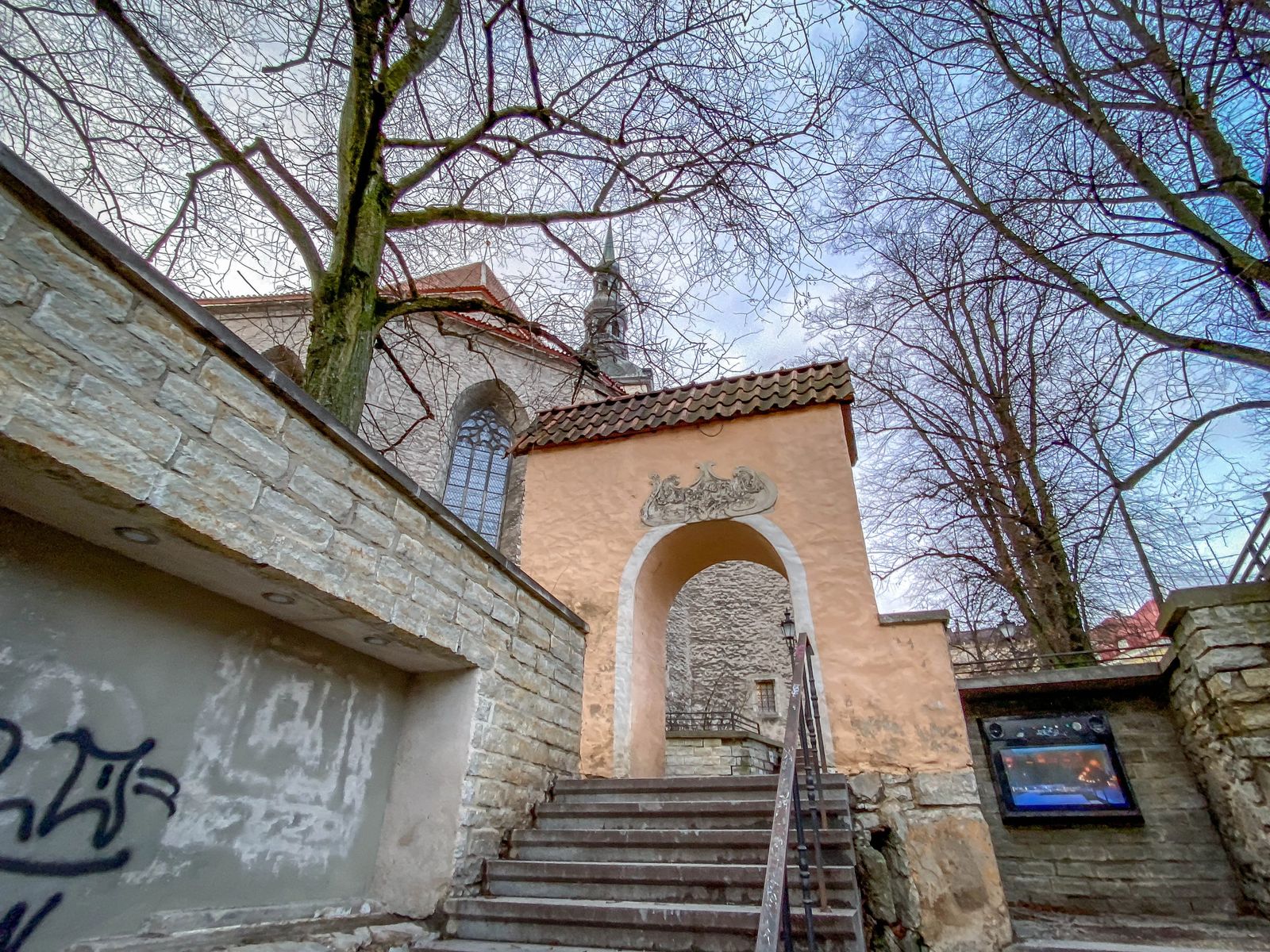
The Eye Of The Needle
This narrow gate that connects Harju street to St Nicholas Church. There was a rule that executions could not be held in the center of the city. After the prisoners were sentenced they were paraded down Harju street.
It was called 'the last road' for this reason. However, if the prisoners were able to repent of their sins from the bottom of his heart, then he would be able to find salvation and escape. The escape often lead through this arch that was named 'the eye of the needle', that led straight to St Nicholas church.
Legend has it that the few that did manage to escape fled to the church and often ended up leading very spiritual lives. Now every Estonian that passes through this arch pays homage to this legend and thinks on their sins and how they can repent.

Getting Around Estonia
If you are arriving by plane, then yes Tallinn has an international airport quite close to old town. There are buses, taxis, and ride shares.
As far as Uber, Estonia does have it, however it is probably cheaper and you have more options if you utilize their own version of Uber called Bolt. Just make sure your phone carrier has coverage in the Baltics, I found AT&T did not, but my friends with Tmobile did. If not, then any restaurant or coffee shop will have Wifi that you can jump on if you purchase something.
Make sure to check local and government websites for the most up-to-date requirements for the pandemic. There were a lot of restaurants that you could not go into without the EU QR code for COVID. Many of them accepted the COVID vaccine card from the states, but they do very specifically check the dates.
If you want to visit Finland, Sweden, or Norway, even St Petersburg - you CAN! You can book a Ferry to any of these destinations, but make sure to book in advance as the best times lots get filled quickly. My friend that traveled with me, was able to come to Finland with me, and then take the Ferry back that night so she could see the Helsinki Christmas Market. It went off without a hitch, even in stormy weather, the ships feel more like cruise ships than they do small Ferrys. There are restaurants and even live music on the ship. I will get more into detail in the article I'm writing about Estonia to Finland Ferry Experience, and all you will need to know.
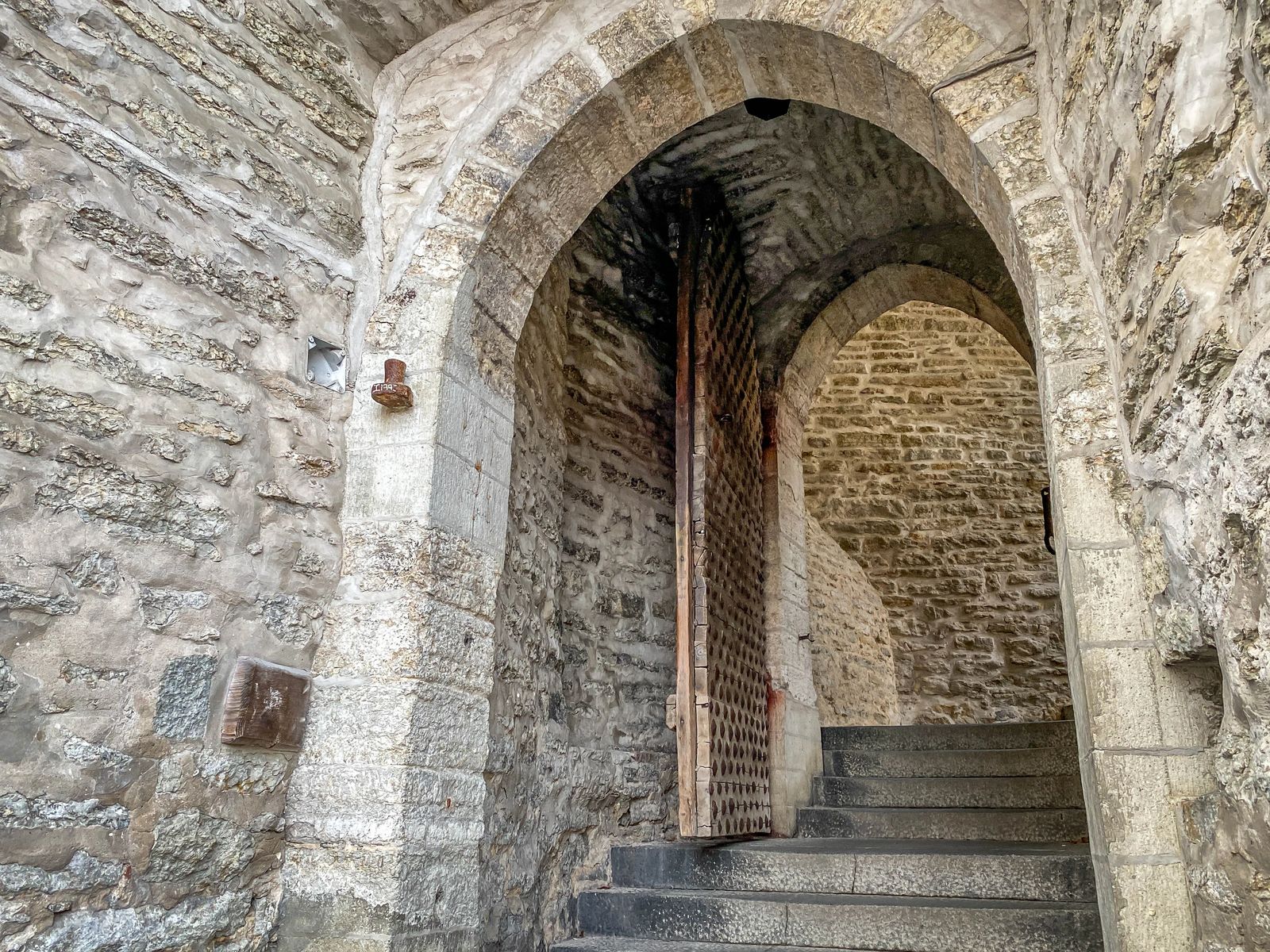
Other Activities in Estonia
Be sure to check out my other articles on the best outdoor activities, best places to eat in Tallinn, Unique Things To See In Estonia, Best Instagram Spots in Tallinn, How to take a Ferry from Estonia to Finland, and MORE!

My Takeaway From Visiting Tallinn
Tallinn is quirky, ancient, full of delicious food and awe inspiring sites! If I had a chance to move to Estonia I probably would, it was that spectacular to me. When I arrived it felt like any other European town at night. When I awoke the next day, it was anything but ordinary though. Within 10-minutes from my hotel (Hotell Palace) I was walking next to ancient medieval walls so well preserved, learning about legends, holding hands with statues of monks, and having my mind blown at the stories.
If you have a chance to visit I suggest visiting in the Spring, Summer, or Fall to be able to go hiking at Viru Bog, and seeing Lahemaa National Park. GO CAMPING even! I have always wanted to do that in a different country honestly, but haven't had the guts. Regardless I would give yourself a week here at minimum to truly see all Estonia really has to offer.
If you want a truly special experience though, visit Tallinn during THE CHRISTMAS MARKET! The entire town gets involved, the fluffy snow on the medieval buildings, and tall spires is so enchanting. They keep all the shops nice and toasty warm, there is plenty to do and see and being from Utah myself, the weather really wasn't all that bad to be honest.
This is truly a city in my top places I've visited and cannot wait to go back, so make sure to add it to your bucket list!
Google Map Of Locations Mentioned
Like it? Pin it! Sharing is Caring ;)

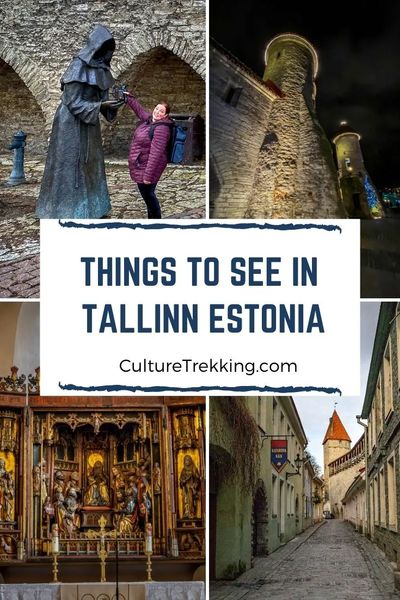.jpg?fit=outside&w=1600&h=2399)
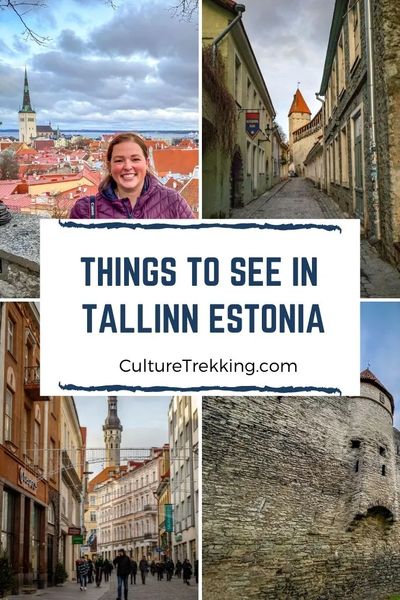.jpg?fit=outside&w=1600&h=2399)
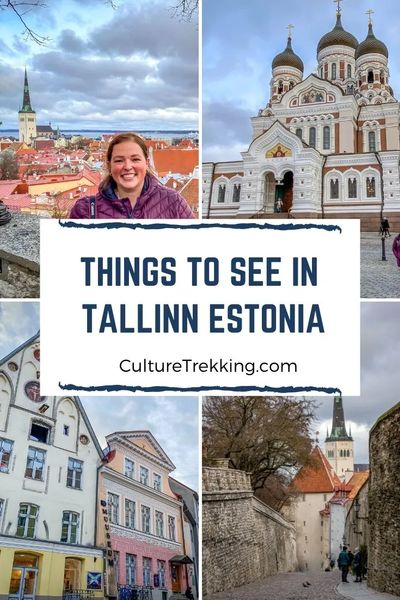.jpg?fit=outside&w=1600&h=2399)
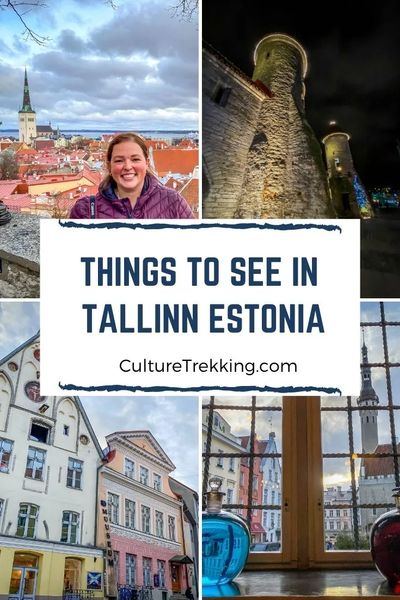.jpg?fit=outside&w=1600&h=2399)
Where To Stay In Tallinn
Latest Articles On Culture Trekking
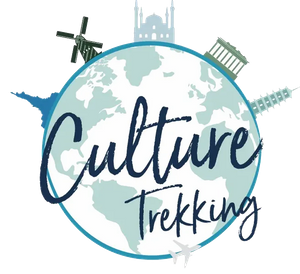

Welcome to Culture Trekking!
My name is Janiel, a leader in the travel industry with over 20+ years of experience with international travel. I specialize in solo female travel, cultural connections, sustainable adventures, food and history to help make your travel experiences fun, meaningful, and delicious. My experience in travel, and my personal story have allowed me to get published in Fodor's Travel, Atlas Obscura, Metro.co.uk, Trip Advisor, and multiple Podcast interviews. You can find me on pretty much every social media channel YouTube, Instagram, Twitter, Facebook, Pinterest, TikTok. To read more about me and my story click here. If you are a brand and would like to work with me, click here.













